Text
The Xbox Everywhere System

This has come up in a couple discords in the last 24 hours, following news that Microsoft is laying off over 9000 employees and canceling half a dozen games (despite constantly exceeding investor estimates). This has lead to some doom and gloom over the Xbox brand, given how it appears Microsoft is consistently rolling over and putting their games on rival platforms.
I don't necessarily think that's true, and I want to explain why.
Now, up top, just know that I've tried to find this article and I cannot. To my memory, it was an interview with an Ubisoft big wig, probably around 2012, 2013, where he talked about the future. I thought, maybe, it was this Guardian interview with Yves Guillemot, but it does not appear to be.
But this interview sticks in my head because at the time it sounded totally insane. This Ubisoft guy wasn't just talking about the launch of the Xbox One, he talked about two or three generations into the future. He was talking all the way out to, like, the year 2028, and just to repeat, this was maybe 2012. He had been talking to hardware manufacturers and was speaking from the perspective of where they were going to drive the market over the long, long, long term. I remember being blown away that anyone could make plans that far out.
He claimed that, yes, eventually hardware would peak. It would become prohibitively difficult and expensive to sell a bump in graphical fidelity, and that plans were coming into place to handle that -- specifically, that the idea of a console would slowly go away. He said that, instead of buying an Xbox or Playstation console, you'd launch all your games from an Xbox App or a Playstation App on something like a Roku or a Chromecast.
He framed it sort of like Netflix, and how you can watch Netflix content on any streaming device you have. He said games would become streaming, too, and this was a good six years before Google Stadia. And truth be told, this is one of the reasons I was immediately skeptical of Stadia, because it felt like Google was jumping the gun and pushing this tech out long before it was projected to be ready. Surprise: that ended up being true. It is also perhaps the biggest indicator why cloud streaming games continues to hang around, even though Stadia was such a massive failure; it was already decided, many many years ago, that this is where things were going.
But the point he was trying to make is that you wouldn't own a console anymore, and you'd be able to play your games on any device that supported the app. Just like Netflix.

Phil Spencer has talked before about how bad the Xbox One was for Microsoft. That was the generation where everyone "put down roots" for their digital game libraries, and now, it's hard to shake them out. Consoles are becoming even more like the PC now, where a digital library will theoretically live forever -- a Playstation 6 will probably have some way to not only play PS5 games, but PS4 and even select PS3, PS2, and PS1 games, too. Nobody wants to start over on an Xbox when they already may have $2000 invested in a deeply entrenched, well-aged Playstation library.
This is where Xbox Game Pass comes in. Generally, Sony, or Microsoft, or Nintendo sells you a game console once every 5-10 years at this point. The real goal is to buy a game. The profit has always been in selling software. Bare minimum, they want you to buy one full-price game a year, maybe two. So we get these big holiday tentpole releases, the one $60 $70 $80 game that year they expect everybody to buy.
Unsurprisingly, a subscription to Xbox Game Pass starts at $75 a year. Now, Microsoft's changed their pricing recently, and it's clear they really want you to go whole hog and spend $120 or even $240 a year on the higher Game Pass Tiers, but the basic Game Pass plan starts at the exact same price a single video game costs. Your one minimum video game purchase for the year now gives you an instant library of hundreds of games.
And the strategy doesn't even really change, either. Microsoft can still have their one big tentpole release every year, but now instead of that being the driver that sells console hardware, now it's the driver that sells the subscription. And if it's just a subscription, why even prioritize the hardware at all anymore? Put the subscription on as many platforms as it can exist on.

I assume this was bolstered by the idea that, originally, if you subscribed to Xbox Game Pass, it would sometimes give you the PC versions of games. Not always, it was finicky, but in the early days of Game Pass you could subscribe to the console service and get select PC games. Which drove Microsoft to build a PC-specific version of Game Pass, and I'm betting that really catalyzed the idea that Game Pass needs to be on everything.
There was even a rumor, two or three years ago, that Microsoft and Nintendo were in talks to bring some amount of Game Pass content to the Switch. I've heard, from people who probably know, that Microsoft was actually shockingly close to closing that deal before Nintendo ultimately backed out. It wouldn't surprise me if Microsoft even tried to pitch Sony on allowing Game Pass on Playstation consoles.
And now the industry is rushing to catch up to Game Pass. Sony has their own alternative, even Nintendo kind of does.
With the recent pricing restructuring, Microsoft even opened it up so that if you're a Game Pass subscriber, you can cloud stream any game you own to your phone. The Ubisoft prophecy is slowly coming true, as Microsoft moves further and further away from the Xbox as a console to solely becoming The Xbox App.

The strategy here is to beat everyone else to the punch. To have everyone already locked into the Xbox App before there's a Playstation or Nintendo equivalent so they can dominate that space unopposed.
This also positions Microsoft as having a vested interest in not only eventually killing the Xbox console, but possibly killing all consoles as a way to drive people towards Game Pass and the Xbox app. This is an extremely long term goal, so we're still not quite at that turning point yet, but I bet it's on their radar as something to do in the future. For now, we're still in the baby steps of getting Xbox software onto Playstation and Nintendo platforms. Think of it as a trojan horse.
This also forces Sony and Nintendo (mainly Sony, let's be honest) into responding. Do they double down and keep making new consoles to spite Microsoft's efforts to become a service that exists on everything, everywhere? Or do they try to head Microsoft off at the pass? Given Sony has been dipping their toes into porting games to the PC, you can definitely tell they are weighing their options.
Now, to be clear, this is a huge gamble for Microsoft. If the market shifts out of their favor, it will absolutely spell the end of the Xbox. They are deliberately weakening their brand, sort of hoping it will be successfully reborn as something else. But if that doesn't happen, they won't be able to recover. They are betting on 13 year old market projections to swing in their favor. They are trying to thread the needle to be first in line while also avoiding the fate that claimed Stadia.
These layoffs are just corporate ghoul stuff. An ongoing problem. The strategy remains.
1 note
·
View note
Text
Listening for the Voices of the Void

If you would rather listen to me narrate this article, all Patreon donors and Youtube Paid Members get a podcast version starting at $1 a month. You can also buy the podcast by itself on Patreon.
I grew up in the 1990's, during a time where UFOs, government conspiracies and alien autopsies were a pop-culture phenomenon. Obviously you have the "X-Files", a television show where federal agents Fox Mulder and Dana Scully were tasked with seeking the truth about whether or not aliens were visiting earth and what their intentions could be.
But it was more than that. The 90s were a host to all manner of alien-themed media, from a prime time TV show like "Sightings", which provided interviews and reenactments of all manner of strange encounters, all the way to multiple hour-long specials focusing on the history of Area 51, Project Blue Book, and purported footage of scientists interviewing alien life and later dissecting it's corpse after it had expired. It was bolstered by movies like "Fire in the Sky", based on an allegedly true account of a hunter being abducted and studied by aliens, and an adaptation of the book "Communion". The movie featured Christopher Walken as an author making contact with multiple different alien races, also allegedly based on a true story. Even the fledgling indie movie scene got in on UFO fever with "The McPherson Tape", a found-footage short movie about a family coming together for a reunion that gets interrupted by interstellar visitors. That one, however, is just a movie; the original in 1989, and the remake in 1998.
I can't be certain, but Voices of the Void feels like it was made in the shadow of such a cultural touchstone. It's become its own growing phenomenon among Twitch streamers as of late, and if you don't follow that scene, let me provide the record with a description of what Voices of the Void actually is:
You play as Doctor Kellin, a researcher assigned to operate a radio telescope array deep in the remote Swiss Alps. Right away, you can tell that something is off. Even though you are so isolated, the whole place is surrounded by high fences designed to deter people from getting in -- and making it difficult for you to leave. You start the game somehow already inside the perimeter. Nobody is at the entrance gate to greet you, and the lone guard station looks like it has seen better days, with its door practically falling off its hinges.

The walk into the facility is a lonely one, and once you get there, the base itself appears to have been abandoned for a long time. Whoever was here before you didn't do a very good job with maintenance, as the interior is completely trashed. There's piles of garbage everywhere and every surface is covered in filth. Despite this, the base is still fully operational. Your only contact with the outside world is via emails exchanged with your boss, another scientist named Dr. Bao.
It is your job to scan the sky for interstellar radio signals, configure the telescope array to lock on to that signal's frequency, record the signal, and then send that recording back to Dr. Bao on physical tape drives. You do this by packing the tape drives into a special padded box, hauling the box out to a loading bay platform, and requesting a pickup via delivery drone. The drone comes in, retrieves the box, and sends it back to the head office. Once received, Dr. Bao awards you currency, which can be spent upgrading the telescope array or buying other items to make your stay more comfortable, like food and home furnishings.
That is, more or less, the basic loop you're introduced to in Voices of the Void.

Now, without spoiling too much, there IS more to it than that, like sometimes configuring the telescope array means having to leave the base and repair problems by hand. You also have a motion detecting radar that will tell you if something enters the perimeter. But by and large you're here to move between computer terminals, so you can scan, record, and ship signals back for further study.
Other systems are laid over the top of this; for example you have two basic needs: eating and sleeping. Neglecting these often have unique consequences, like hallucinations and nightmares. Your character also has health, with a variety of different ways to take damage and various medicines to heal it again.
Fuel must also be managed, in batteries for your flashlight and gasoline for the ATV you drive around the property. Finally, the start of each new day is marked by bonus tasks provided by Dr. Bao, like requesting signals of a specific quality or asking you to record calibration data from satellites and including that in your next shipment.
I'll be honest with you. It's not very exciting, at least not when you first start out. It can be a surprising amount of work, but it's very dry, routine work. And that's by design.

It's important to note that Voices of the Void is supposed to be a horror game, it just doesn't work like most horror games. Obviously, more happens in this game than just analyzing interstellar broadcasts. Though you're meant to be largely working at the in-game computer, the game has a number of bread crumb trails designed to get you poking around in the outside world, where a number of further mysteries await.
Dilapidated cabins boarded up from the outside. Ominous statues exalting Gods of the forest. Abandoned construction sites where a violent event seems to have occurred. A pair of lonely headstones overlooking the trees. Strange objects located around a campfire in the outskirts. Suddenly, a meteorite crashes. Or is it something more?
There's a contrast at play here, where the game is meant to be this slow, methodical job simulation punctuated by spikes of what some would refer to as "High Strangeness." That dichotomy is at the heart of Voices of the Void; long valleys of quiet and sharp peaks of horror.

The secret sauce that ties everything together is the feeling of anticipation. One streamer I've watched play Voices of the Void is Joel Vargskelethor, one of the lead members of the Vinesauce group. Joel, by his own admission, is terrified of aliens, but also clearly identifies the entertainment value in sharing his fear with the internet. He was an early adopter of Voices of the Void, possibly even the main driving force that exposed the game to a wider audience.
Joel latched on to Voices of the Void through another game he enjoyed a few years ago called "Signal Simulator." It featured the same basic structure as Voices of the Void, but lacked much of the depth that has come to define the game. Joel eventually dropped Signal Simulator once the creator made a hard pivot into clumsy, meme-based humor. Fortunately, a little over a year later, we received Voices of the Void from a different developer, MrDrNose, and though they are two separate games, Joel is adamant that he thinks of it as a sequel to Signal Simulator.
According to stream archives available on YouTube as of this recording, over the last two years, Joel has played Voices of the Void for somewhere around 128 total hours. By comparison, he only played Signal Simulator a little over 30 hours before dropping it. Combined, there's a solid week's worth of videos to marathon, assuming you don't take any breaks to sleep.

My point is, I've seen a lot of this game, particularly the early parts of this game, as Voices of the Void has often required Joel to reset his save file after every major update. I've witnessed how things escalate, and I know at least some of what's waiting for me.
Knowing that, knowing how this game's tone can shift dramatically, imparts an increased paranoia in starting Voices of the Void for myself. Every time a server's hard drive shudders or a distant pine cone falls to the ground, it sets you on edge. The truth is out there and it's coming to get you.
To shift perspective a little bit, it's sort of like another horror game I've been playing recently, "Alan Wake." That's a game where you play as a horror novel author, and it's a mechanic that you find pages of Alan's next book that are often describing future events that are later in the game. What's written is never anything that will make you scream in terror, but it's all about the paranoia of waiting for that other shoe to drop. Knowing that a monster is coming and trying to put together the clues as to when.
This is the bread and butter of Voices of the Void, which luxuriates in a long tail of tension. There are big stretches of time, hours and hours, where basically nothing is happening except capturing signals. I made the mistake of trying to stream some of this game for my friends, and they had a lot of fun playing the skeptic and rolling their eyes at how jumpy I was over small, insignificant things. They don't really like or play a lot of horror games, so I was constantly warning them that we were coming up on a part where the game was going to be scary... only for it to peter out into nothing, nine times out of ten.

Voices of the Void is not a game you play expecting to jump out of your skin in the first 30 minutes. Not even in the first hour. Or, heck, maybe not even in the first four hours, if I'm being honest. It's a slow burn of hearing a noise out in the woods and not knowing what happens next.
And part of that is due to the way the game itself is structured. You may think, having watched 128 hours of this game, that I know the whole thing front to back. Nothing could be further from reality.
The core gameplay of Voices of the Void could have been, and sort of was considered "finished" a long time ago. Scanning for signals and what comes from that has seemingly been done for a while now. Instead of wrapping up and moving on, though, MrDrNose identified its popularity among streamers and has spent the last year and a half continually adding new, optional events and revamping the game's map. Voices of the Void is now home to somewhere around two dozen creatures and events, and often only a handful appear in a given playthrough.
Despite having watched Joel play so much of this game, my playthrough is already marked by a lot of things I've never seen before. For example, one night my radar pinged that something was only 20 feet outside the facility. Peering out the command center window, I could see something on the edge of the property, and it was the sort of thing where it kinda looked man made. I couldn't tell if it had always been there or not. Cautiously leaving the base, I discovered that it was... a door.
Just a door.

Not connected to anything, mind you. Just an ordinary, plain, white door, made of wood, like you see in a house. It was propped up out in the grass. I could not open, pick up, or otherwise remove the door. Sometimes, in the middle of the night, the door opens by itself to reveal a tantalizing glimpse at what appears to be the gateway to another dimension. What's on the other side? I'll never know. In 128 hours, I can't remember Joel ever seeing anything like this.
And it makes you wonder: what else is in this game?
New things are being added to the game so secretly that it kind of creates a mythology for them. Though I don't recommend spoiling yourself on things you haven't seen yet, there's a whole section on the Voices of the Void wiki listing creatures and events that players are still learning about, either because they are brand new, or because they are so rare that information about them is sparse. And rather than data mine that information out of the game's code, many players seem to respect the mystery.
There's a real home-grown quality to it all, mirroring real-life communities centered around identifying paranormal phenomenon. Poorly taken screenshots and circumstantial descriptions of events, some of which may not always be correct or up to date.
And it's not just creatures, either. Voices of the Void has expanded to include cooking mechanics, home decoration, fishing, and cleaning. Actually, once upon a time, your base started out totally spotless. Now, when you arrive, it's covered in garbage. How you deal with the trash -- or whether you deal with it at all -- is completely up to you.

Though as a general piece of advice, cleaning up the base is a good way to earn currency at the start of the game. Signals take time to get recorded, and some early signals can take more than a full day in-game. Scrubbing down the bathroom with a bucket and sponge will earn you a decent bit of currency, and bagging up all the garbage will let you pack it all into an item box you can sell to the main office, presumably for recycling. Until I had enough upgrades under my belt to start completing Dr. Bao's daily tasks, recycling garbage was my primary source of income, and more than just the main base has trash to be picked up.
But ultimately what I appreciate the most about Voices of the Void is that it feels like the sort of game I was trying to make. This is going to take a bit of unpacking, but many many years ago, when I was still in high school, I joined a community exclusively dedicated to producing Sonic the Hedgehog fangames. The franchise was just starting to come out of a big lull, and in the interim, fans were making their own games to fill in the gaps.
One thing we liked to do is that we would create and share around customized sprite sheets of our Sonic OCs so that we could cameo in each other's games. The most common format for these were top down isometric sprites, almost like the kind you'd see in a vintage RPG.
Everyone I knew back then made games with what is now known as Clickteam Fusion, and often our sprites were shared pre-configured within a Clickteam Fusion project file, making it fast and easy to import them into another game. Everything was already set up, you just copied the character object over from one project to another.

One night, having built out the character sprite for my OC, Blaze the Hedgehog, I found myself bored. Nobody was online, so I was sitting on finished sprites with no one to send them to. So, I began to play around with my own sprites. I kitbashed different assets together and built a simple little level for my character to run around in. There were some ugly trees, a couple headstones, and a few zombies to shoot at. The next morning, after one of my friends had played this mini-demo game, he confessed that he actually thought it was kind of scary.
I was confused. Was he really scared by it? I certainly wasn't setting out to make something scary. And maybe for the first time it really got me to stop and ask myself: What makes something scary? More importantly, what makes a video game scary? Like, I knew that games like Resident Evil 2 or Silent Hill were scary, but why? Days passed, and the question continued to haunt me.
As I sought that answer, the tiny little level blossomed into a gigantic maze in a game I eventually called "The Darkness", around 2001 or 2002. The Darkness mainly traded on atmosphere, with a foggy graveyard full of monsters. Actual encounters were somewhat rare, but as you played, you could hear the monsters make noise elsewhere in the maze. Zombies would groan, but you never knew where they were until they appeared on screen, creating a small amount of tension.

Even after The Darkness was complete, I was unsatisfied. I felt like I had made the video game equivalent of a Halloween Spooky Sounds CD. There was clearly a lot of untapped potential I wasn't yet grasping. I attempted a sequel to The Darkness, but still struggled to figure out something that felt right. The Darkness 2 was just another maze; one that was smaller, more detailed, and more narrative driven than the first game. Instead of a graveyard, now you were trapped inside of an old, dilapidated mansion, and you needed to find keys in order to progress.
This meant creaky floorboards and windows illuminated by flashes of lightning -- real vintage horror concepts. I also played around with concepts like enemy ambushes, even small amounts of blood and gore. But it still didn't feel right to me. I was just going through the motions. Repeating what I knew worked in other games. I wasn't really advancing my understanding of what a horror game truly felt like, or how to make a player afraid of what may happen. So I went back to the drawing board.
Rising out of the ashes of The Darkness 2 was a game I called "The House." By now, it was 2005. I had decided on two pillars that would generate a sense of fear in players. The first one was immersion. The word "immersion" is kind of considered a dirty word now by some people in gaming, but the general idea was to connect the player to the game somehow. To make them care about the person on screen they were playing as and avoid breaking that connection as much as possible. So my Sonic OC, Blaze the Hedgehog, was out, replaced by generic male and female characters meant to represent the player. The game also opened by asking the player what their name was, further strengthening the connection and hopefully making the person sitting at the keyboard care about what was going to happen. I'd address them by name during the game's intro, and should they die, their name would headline a newspaper obituary that was displayed on screen.

Beyond this rudimentary immersion, the second pillar of The House was to exploit the natural fear of the unknown. Even though they were mazes by design, both Darkness games were ultimately linear experiences. You were working towards the end of a given level, which was a known source of safety. Scary events were then lined up in an expected sequence as you progressed through the level, slowly growing more intense until they reached a crescendo. But they always happened in the same places. If you knew they were coming, they ceased to be scary.
For The House, I had an idea: What if there was no "level"? Instead, you entered a realistic space with no obvious beginning or end and were free to explore it at your leisure. This space was the titular house itself, a two-story structure with a foyer, study, six bedrooms, one bathroom, a huge dining room, and a kitchen. I was trying to imbue the game with some sense of an open world, even though it was only just a house.
The trick being that since the game was now technically non-linear, you couldn't really pace scary events in a traditional way. Players could move through rooms and solve puzzles in whatever order they chose, meaning that if I wanted to surprise them, I'd have to get creative.
What I ended up with was a tiered system of scary events, from small little things like a radio turning itself on when you were out of the room, all the way up to bigger things like plates flying off the dining room table or even monsters spawning into the game world. Behind the scenes, an AI director would control the flow of tension, with the idea being that as you naturally moved through the house, scary events would happen to you dynamically, no matter where you were or what you were doing. One player may head down the stairs through the foyer and see nothing scary at all, whereas another player may take that same route and have the chair in front of the piano move across the room by itself.

By being unable to determine when and where scary events were about to happen, I hoped to lull players into a false sense of security and then surprise them with something unexpected. And it was all handled systematically. Scares would ramp up, hit a peak, and then fall back off. Every time things would peak, the scare limit would be raised a little bit. That would mean that, over time, bigger scares were possible, and smaller scares would last longer, until players either discovered how to safely escape The House, or they were killed by the monster lurking within.
To me, that felt scary. Or it would have, anyway. There were a lot of things wrong with the game; the house itself was too small, for example. I did zero research and knew basically nothing about architecture, so I just created what felt like a big house to me. But you could traverse its entire length in just a few seconds. There also weren't enough scare events; some rooms didn't even have any scares in them at all. And I was inexperienced with writing horror stories, so the quality of various notes and books in the game suffered -- some were even stolen from websites like Something Awful, something I now deeply regret. I eventually removed all of my downloads for The House as a result.
A first-person sequel to The House has been one of those ideas I've taken with me in the two decades since. I had planned to frame it as sort of a found footage sort of game, and back in 2005, it would have been one of the first. Instead of a simple house, you would have explored an old, abandoned hotel in a mining community. This would have naturally provided more space to work with, and I'd even considered having the hotel double as a train station. If nothing else, it would give me an excuse to let players explore a spooky train yard.

You would play as a cameraman, shooting video of another character, a partner, who would provide a bit of running commentary as you explored. I pictured her sort of like Half-life's Alyx Vance: sharp, tough, and capable. She'd tell you about things you couldn't necessarily experience for yourself, like describing smells or the feeling of texture. More immersion. You'd mainly have video camera controls, like zoom, focus and rotation, but you could also point things out to her and have her interact with them for you. She could climb through broken windows, crawl through vents, and get to places the player couldn't, thanks to their big, heavy camera. These were still the pre-smart phone days, after all.
The idea was to give the player the safety and comfort of having another person with them, and then take that away. A sudden, unsettling silence. Together, you would discover the secrets that lead to the hotel being haunted.
This has been a huge tangent, but I never followed through. Clickteam Fusion largely only allows you to make 2D pixel art games, and I envisioned this as a full detail first person game rendered in 3D, something I never learned how to create.
The point I'm trying to make is that Voices of the Void feels like the natural destination for the ideas I was experimenting with, now 20 years ago.

You are dropped into an open world, free to explore in any direction at any time. It's designed as a realistic, functional space, where everything is laid out naturally. What you see and when you see it can be completely different for each player. And though you don't get to name or decide the appearance of your character, you can personalize your base and make it your own. It is a systems driven horror game that builds a connection with the player and stokes a fear over never knowing what will happen next.
I don't know if I could have made a game like Voices of the Void, but it is the game it feels like I was trying to make. I'm glad to see the pillars I thought were important seemingly prove their worth.
And Voices of the Void still isn't even done yet. MrDrNose recently showed up in the latest Joel stream to say he's in the middle of a major update for the ATV you drive around the map. Voices of the Void is currently on version 0.8.2 as of this writing, and given the typical update cycle, we could be looking at a minimum of two more updates before it reaches its 1.0 milestone. And given the typical length of time between updates, that could probably be more than a year away. Maybe then the game will finally, truly be complete.
I should also probably point out that, technically speaking, Voices of the Void is free. It's listed on Itch.io under the "pay what you want" option, with no minimum. If you're curious about the game and want to try it out, you can just download it now and then pay for it later, if you're able to. And, honestly, what have you got to lose?

It's pure speculation on my part, but it wouldn't surprise me if the eventual release of 1.0 marks its official debut on platforms like Steam and probably a new, permanent, locked-in price. The game certainly deserves to be paid for, and if MrDrNose does actually intend on 1.0 being the final release, I can't think of a better way to end it then cashing in on what will have been 4 to 5 years of work. This dude has been leaving money on the table for too long. Then again, I don't know how many people have actually paid for Voices of the Void, or how much they paid for it. I'd hope he's comfortable regardless.
This might also be a good time to talk about the aesthetic of the game, which may present a roadblock when it comes to officially selling Voices of the Void on Steam. Like a lot of indie first person games, Voices of the Void has a visual identity that could be described as a very polished Playstation 1 or even Dreamcast game. Though it feels rude to describe things like this, objects in the game have enough detail to be identifiable, but maintain a rough, chunky, crunchy feel. There are also a number of optional filters to push things even further, dropping both the resolution and color depth to even greater retro levels.
But the main thing that sticks out to me is the presentation within this aesthetic. Voices of the Void is developed inside of Unreal Engine 5, but you'd never know that, considering every part of it feels designed more to invoke the feeling of Valve Software's Source Engine, and specifically, the feeling of Garry's Mod. Not only does Voices of the Void start up with a long, unskippable process of generating item thumbnails, something that used to be a frequent problem in Garry's Mod years ago, but many of the menus and in-game notifications are stylized after Garry Newman's landmark sandbox modification.
Heck, you can even get a crowbar to swing around, if that's what you're looking for.

Even the sound effects are pulled straight out of Half-life 2. Familiar sounds of scraping wood, footsteps on concrete, or the chomph chomph chomph of climbing a ladder are all present and accounted for. It is an immediately identifiable soundscape.
Which makes my theory of selling the game tricky. A lot of Half-life's sounds are from stock sound libraries, which technically need licenses in order to be used, though how those licenses are managed is beyond my knowledge. A lot of older sound libraries were publicly sold on CD's which often end up on Ebay or Amazon now. Just about anyone could have legal ownership of even the most mainstream sound libraries for a couple hundred bucks or less.
Still, though. Pretending to be one game while simultaneously being another could ruffle some feathers among people who could prevent its sale. There may be a reason Voices of the Void continues to stay as a pay-what-you-want game.
For whatever reason, Voices of the Void has become a game I've never seen anyone talk about in the big name games media outlets. Despite its moderate popularity on Twitch among some bigger name variety streamers, it has yet to receive its big breakout moment. Maybe they simply think of it as streamer bait.

To be perfectly honest with you, that's kinda what I thought about it, too. The entire reason I finally installed the game and tried it for myself was to investigate whether or not there was more to Voices of the Void than streamers like Joel cracking jokes and screaming at aliens.
Turns out, there's a lot going on here. In some ways, it kind of reminds me of Minecraft, in that Voices of the Void is a constant stream of little tasks that keep me so engaged that it's borderline dangerous. Loading this game up is a great way for six hours to just disappear without a trace. There's always one more thing that I can do, or one more thing to make the base better, or one more anomaly to chase down, or maybe something unexpected just completely catches me off guard and now I have one more mess to clean up. I am never bored when I am playing this game.
And there's definitely a tipping point too, where after recording signals for long enough, you are rewarded for your patience with an ever-increasing barrage of weird, scary, and sometimes even funny incidents.
Sometimes, it's something as simple as someone (or some thing) leaving you a gift of special food in your bed. Other times, it's a nightmare of being chased by mannequins. Or being lost in the Hamburger Dimension. And whatever you do, do not look in the locker.

That's the thing about Voices of the Void. Sure, we've had job simulator horror games before. But this is more than that. It's more than just scary. It's more than just mundane. This is a brilliant game that exists in a class of its own.
There's simply no other horror game out there with a world this big, that has this many mysteries or this much variance to the experience.
As long as you're patient and curious, there's a lot to love. Don't miss out.
7 notes
·
View notes
Text
I Have Complicated Thoughts About Mother 3

Note: Patreon donors can listen to this article as a podcast narrated by me. Click to learn more.
Confined to a tiny room, I pulled out my off-brand retro portable and loaded up the fan translation of Mother 3. It had been on my list of "important games to play" for literal years at this point, if not more than a decade, and playing Mother 3 was bottle necking a lot of other stuff -- for example, I also wanted to play Undertale, but swore I'd need to finish Mother 3 first, despite being very graciously gifted Undertale only a few months after it came out on PC.
Being something I wanted to play, that obviously meant avoiding spoilers. When the ability was added to places like Twitter or Tumblr to block specific keywords, often the first one I'd block was "Mother 3" alongside the names of a handful of characters I knew like Lucas, Claus, and Kumatora.
I'd played a couple hours of Mother 3 once before, right when the translation patch first came out, so I knew what happened in the opening scenes of the game. I knew what a gut punch it was. It definitely worried me, because as I started the game back up, now in 2021, I silently thought about what it would be like playing a game that starts with your player character's mother dying, as I looked up at my own bed ridden mother.
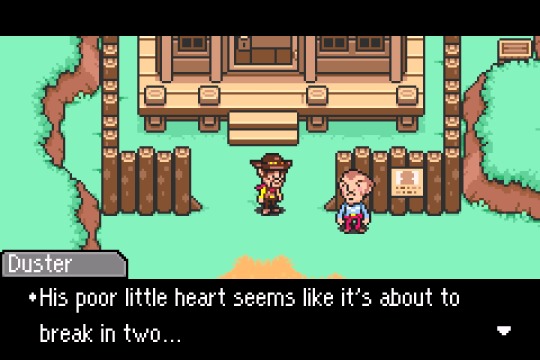
It was May of 2021 that she developed debilitating back pain. There was an easy enough explanation for that; we had just gone through a hellish (and potentially legally dubious) renovation forced upon us by the corporation that owned our gigantic apartment complex. Due to a scheduling error, we had less than a week to pack up our whole apartment so they could move us out, renovate the unit, and then move us back in. We attributed her back pain to that moving process -- lifting cardboard boxes and such.
But the back pain kept getting worse. They prescribed her stronger and stronger medication for what they claimed was sciatica, but it never seemed to help. After multiple trips to the emergency room, she was finally admitted to the hospital proper, where her femur randomly shattered during a routine procedure. The femur is the longest, strongest bone in your body, and typically only breaks during extremely violent impacts, like car crashes and stuff. For my mother, it broke as nurses were shifting her around to clean her bedding. Tests for bone cancer seemed to come back negative, so the doctors shrugged at us and considered it a freak accident and just the toll of old age.
There was no way she was making it back up the stairs to our apartment any time soon (if ever), so it was decided she'd have to heal from that broken leg at my brother's place, and since my brother and his wife both work day jobs, I volunteered to take care of my Mom while she got better. Hence why I was stuck in this tiny room, booting up Mother 3 in July or August of 2021.

My Mom never got better. It would be eight months before they told us they had somehow missed detecting her cancer, and by then, it had spread so viciously they weren't even sure where it originally started from. By the time they told us this, she had only days left.
Every step of the way in those 8 months, as she insisted over and over she was healing and told me about all the things she wanted to get back to doing, I believed her. But my Mom also taught me to always expect and brace for the worst. So as I watched Mother 3's Claus and Lucas bury their own deceased mom, there was an undeniable heaviness swelling in my heart. A feeling I could not shake. Though I didn't know yet, I knew something wasn't right, even if the doctors continued to shrug as more symptoms mounted. I could see myself in the same shoes as Claus and Lucas, and I didn't like it.
Once upon a time, I loved RPGs. I cut my teeth on Final Fantasy 2 for the SNES. Though to be honest, I don't remember my time with it very fondly. I didn't really understand the genre; I thought "hit points" referred to points on the body you could be struck at. Like, your elbow is a hit point. Your ear is a hit point. So on and so forth. When the game told me a monster like Scarmiliogne had "3,000 Hit Points", I figured that meant he was a giant, and thus had more surface area to strike at. I was not a very bright kid, but in my defense, nobody ever bothered to correct me, either.

The first RPG to really stick out in my head was Earthbound (known in Japan as Mother 2). On the surface, Earthbound felt like a kitschy look at hometown Americana, as filtered through the lens of a Japanese writer. Though Earthbound sort of focused on contemporary America when it came out, to me, it's always carried this vibe of Norman Rockwell by way of The Peanuts gang. Though you chat it up with mohawk wearing punks, visit video arcades, and order pizza over the phone, something about its story feels deliberately retro and nostalgic, even in the mid-90's when it first came out.
Earthbound is about leaving home for the first time, feeling sad about it, and calling your Mom at a payphone to cheer up. It's about taking on huge responsibilities while you're still just a kid swinging a baseball bat. It's about going from your house on a dirt road and traveling all the way up to the big city and beyond. It's about making best friends and bullies, and some of those story elements hit close to home for me. It's about finding an inner strength you didn't know was there, and to keep going, no matter what. It's about music and the secret song that plays in your soul.
Earthbound is a warm, deeply heart-felt game that also happens to feature zombies, bubblegum chewing monkeys, time travel, secret civilizations full of unknown creatures, and a sequence where you beat up an entire police force one cop at a time.
That is not the kind of game Mother 3 is.

I suppose I wasn't really sure what I expected Mother 3 was going to be. All I'd really known was Earthbound, plus the 5 or so hours I'd played of the original NES game, retroactively renamed from "Mother" to "Earthbound Beginnings" in 2015. The retro Americana vibes I felt in Earthbound are even stronger in Beginnings. Though the story of Earthbound Beginnings claims it takes place in the 1980's, the visual identity rings much closer to the 50's or 60's. One of round vintage Cadillacs, greasers with big pompadours, and roaming hippies preaching peace and love.
Mother 3 deliberately obscures when and where it's set, for reasons that will eventually become clear. You better get used to it too, because holding information back is kind of a running theme.
Because if I'm being totally honest, I didn't like Mother 3. And at first, I was struggling to figure out why. Earlier when I said "I loved RPGs", that's because my life changed to a point where I felt like I didn't have room for them anymore. Games with lots of dialog meant they demanded my full, undivided attention. When I was sitting at a TV or a computer, I was often multitasking between multiple forms of output -- I'd be doing work while watching a Youtube video or listening to a podcast, and that slowly began to push out story-driven games like RPGs in favor of lighter, more replayable experiences I could engage with while I also did something else.

The one place that was not true was in the portable space. I didn't have a smartphone for the longest time, so I'd often find myself in a commute or on a lunch break at work with nothing to do but pull out something like my Nintendo DS and crank away at an RPG. I devoured games like Final Fantasy IV, Phantasy Star Zero and Bowser's Inside Story. Even games I did not particularly like, such as Kingdom Hearts re:Coded and Pokemon Pearl ended up getting a lot of play.
At some point that changed, and it changed so gradually I didn't even realize it for the longest time. Over the last ten years I have tried and failed to enjoy portable versions of Final Fantasy V and Final Fantasy VI, and found neither game to my taste. FF5 felt far too boilerplate in terms of structure and I simply got bored of it halfway in. With FF6, hype had led me to believe it was some kind of life-changing RPG super-classic, and I came away extremely unimpressed with both its story and its pacing.
Both FF5 and FF6 came at a time after I'd finally gotten a few Android devices of my own -- in fact, most of Final Fantasy V was played on a Samsung tablet while I was at work. By now, I was starting to question whether or not having breezy mobile games like Pac-Man 256 was hurting my ability to commit to longer RPGs, even in the last space where it felt like I could sit down and focus on them.
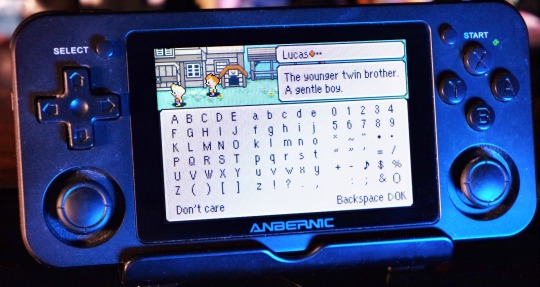
This is sort of what spurred me to start Mother 3 at all: since I was at my brother's place, my desktop computer and most of my video games were on the other side of town. All I had with me was a 12 year old laptop that was only good as a word processor, and a handheld emulation device called an "Anbernic". As the weeks stretched into months, I needed something to do or I was going to go insane. It seemed like no better time to knock something off my bucket list, but now it was starting to feel like strike three with portable RPGs.
My malaise only added fuel to the fire: am I now simply too distractible everywhere? Would I rather be playing simple, quick-hit arcade style games, forever?
It seemed like the perfect scapegoat, too. Maybe the problem wasn't that Final Fantasy VI hasn't aged very well, and more just the fact that my tastes had changed. After all, Final Fantasy VI is deeply beloved and considered one of the best games in the series. Perhaps I was the problem.
But that's not entirely true. The problem with FF6 is that its story simultaneously felt too complex and dead simple at the same time. By now, I was engaging with RPGs where I'd only play them for 20-30 minutes once a week, and I could never remember what was going on because the plot felt like it was over my head. But when a major event would happen, it was always conveyed in this rushed, shallow way. The reason I could never remember what was going on is because nothing ever felt important enough to leave a lasting impact on me.
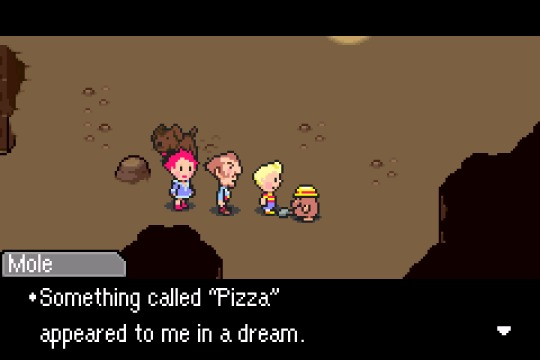
That was never true with Mother 3. Even though it took me close to three full years to finish it, it wasn't that hard to recall where I'd left off, even if "where I'd left off" was over four months ago.
No, the further I got into Mother 3, the clearer it became that I was not vibing with the story.
Whereas the first two Earthbound games seemed to be deeply mired in warm feelings of childhood nostalgia, Mother 3 is a bitter, angry game about how much growing up sucks. All three games are of children coming of age and taking their first shaky steps into adulthood, but whereas Earthbound wields rose-tinted sweetness, Mother 3 grabs you by the neck and lays out a cold, harsh reality.
You play as Lucas, who has a twin brother named Claus, and a father, a cowboy named Flint. The death of their mother shatters their entire family; both Flint and Claus have emotional breakdowns, the latter of which ends in Claus running away from home and Flint leaving to go find him. Both of them vanish. That leaves you, as Lucas, in the care of your grandfather, Alec.

Unfortunately for Lucas, the accident that killed his mother was only the start of a dangerous chain of events, and he soon finds himself swept up in adventure in the way RPG protagonists generally do. Earthbound set itself apart from typical RPG tropes by getting away from fantastical elements and basing itself in real life (albeit a strange, exaggerated version of it). Places with bicycles, fast food, and ATMs.
Mother 3 generally avoids this. You're introduced to Tazmily Village, an isolated farming community of log cabins and dirt roads, buried deep within the heart of the Sunshine Forest.
It's not really known when or where Mother 3 is set. Compared to Earthbound's attachment to contemporary America, Sunshine Forest and the areas surrounding it feature strange creatures like dragons, and even old, dilapidated castles. And yet Mother 3 also seems to have more in common with the wild-west-era American frontier than it does anything else, but even that isn't quite right.
Tazmily is presented as the ultimate in idyllic life. It's a place where everybody helps everybody, intrinsically, out of the goodness of their own hearts. Poke around at the start of the game and you'll find that though they do have a jail, it's never been used, because nobody has ever committed a crime.

Until one day, a mysterious man named Fassad appears. He's quick to charm the residents of Tazmily, and introduces the village to the concept of money. He also introduces the concept of deception, as in the night, Fassad steals some of that same money, sowing the first seeds of greed and distrust in these simple people. This rapidly transforms Tazmily from a sleepy, easy-going community to a bustling town of paved roads, automobiles, and even, thanks to further gifts from Fassad, technological entertainment delivered by his "Happy Boxes" -- cubes with embedded, glowing screens that emit a hypnotic signal intended to make people feel good (and more willing to spend their newly acquired finances).
As Lucas, you oppose all of this. Fassad is clearly an evil, scheming man, both establishing and sabotaging a structure of financial power for his own gain, and its changing Tazmily for the worse. Since Fassad has arrived, Tazmily has seen an increase in monster attacks, and eventually even freak lightning storms that destroy whole entire buildings -- which coincidentally always belong to people that oppose Fassad.
Funny how that works.

After Lucas and his grandpa Alec accuse Fassad, he uses his foothold with the people of Tazmily to brand you as a traitor. The very people that once treated you like family now curse your name for daring to threaten their modernized way of life. Soon, the first mayor of Tazmily officially disowns you, your grandfather is locked up in the newly built elderly care center, and your house somehow ends up being the next thing obliterated by the mysterious lightning storm.
It's a hell of a first impression. The dominating message Mother 3 sends in its opening chapters is that things used to be better. Back when it was just people helping people, before the days of television, and cars, and roads, and even money. When the only thing that mattered was the sweat on your brow, the food in your stomach, and where the sun was in the sky.
It felt cynical to me. Jaded. Things were different in 2006 when Mother 3 first came out, but it's hard not to read that today as some extension of the tired complaints around having too many devices and too much convenience. Like that meme that simply blames all of society's problems on having a phone. And it's a well Mother 3 goes back to over and over and over again: that Fassad brings the corruption of money, the corruption of technology, and the corruption of modern civilization, turning the residents of Tazmily into rude, vapid, ignorant zombies who have grown complacent with the increasingly bad things happening around them.
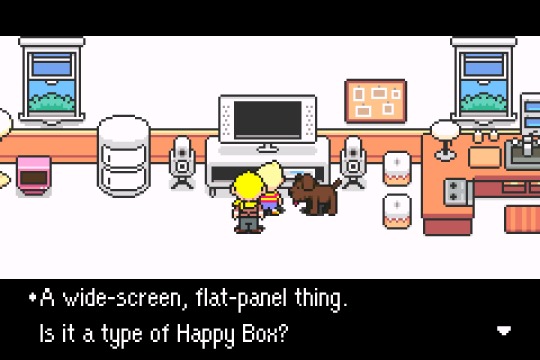
And that's not the only thing in the game that can be read as cynical, either. More than once Mother 3 presents us with scenarios where Lucas faces down adult responsibilities and uses this as a way to express something depressing or frustrating as just being the way the world works. Such as early on when Lucas has to enter a factory as a new employee, and we're told about the joys of child labor -- including the hard hours you're expected to work for minimal pay.
Or how about when you receive a fast travel vehicle halfway through the game. Not only will it become permanently unusable if you accidentally allow it to run out of fuel (pretty easy, considering there's no visible fuel gauge), but refueling it incorrectly will cause it to explode, also rendering the vehicle useless. After all, you're just a dumb kid, and complex machines like these are meant to be cared for properly.
Some of this is definitely meant to be more funny than serious or soul crushing, but the whole game has this rough edge to it that wasn't there in the original Earthbound, where Lucas brushes up against some fact of adulthood and it serves as an uncomfortable lesson. I couldn't help but read it as the game imparting something about how much growing up sucks, and how much that's just a part of life. Your parents will die, your neighbors are ignorant, work sucks and you'll probably mess it up anyway. Get over it.
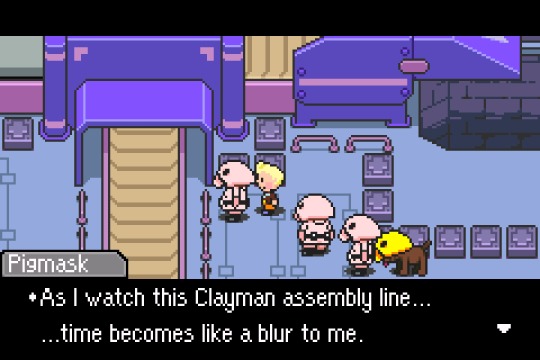
I even got this impression coming from the game's own upgrade systems. Both Lucas and another party member Kumatora can learn PSI abilities, which are basically the game's magic spells. When Lucas or Kumatora gets strong enough to learn a new PSI ability, they break out in an uncontrollable fever, a status effect that limits your ability to do certain things like sprinting. Until that fever breaks, you have to slowly walk everywhere.
It doesn't really add anything to the experience. It doesn't make the game more fun, or more exciting. It's just one of those annoying things you have to put up with, because again, that's life, kid. Sometimes you get sick and you just can't move very fast.
The overall vibe of cynicism gets even worse as you start encountering Mother 3's handful of references to Earthbound. Mother 3 may go out of its way to forge a narrative separate from Earthbound, but there are definitely more than a few scenes referencing special moments from that game, and at least to me, all of them felt extremely pandering. It was as if Mother 3 was beating me over the head, jumping up and down shouting, "It's that thing you remember! Do you remember? Remember Earthbound? Look, we can do that thing too!"
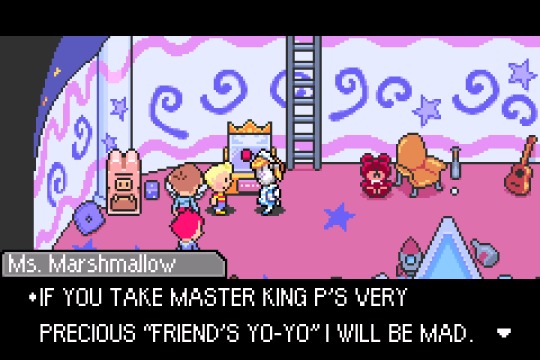
The further you progress in the game, the more these references change from feeling pandering to almost being mocking. It's eventually revealed that the game's true antagonist, and the man giving orders to Fassad, is Porky, the mean little rich kid from Earthbound. Porky has now become a man who seemingly lives in the past, having constructed multiple shrines of mementos from his adventures battling Ness and friends in the previous game. The ultimate version of this is his monument to nostalgia, New Pork City, the final area of Mother 3.
It's effectively one gigantic theme park patterned after the major locales of Earthbound, all focused around celebrating how great Porky was back then, and how great he apparently still is.
And again, it felt unnecessarily angry. Just like how Fassad conquered and spoiled the idyllic village of Tazmily, Porky had taken ownership over Earthbound nostalgia and made it feel dirty. It felt like Mother 3, a game that went out of its way to be so different from Earthbound, sometimes almost shockingly so, was now spitting directly in my face. Porky, the ultimate obnoxious loser who just won't go away, refuses to let go of Earthbound. And you don't want to be like Porky, do you?
It started to feel insulting. Several times over the course of playing Mother 3, I was considering quitting the game and never looking back because it seemed to be going out of its way to twist the knife. Was Mother 3 somehow bitter about Earthbound's legacy?

Again, I had done my absolute best to avoid spoilers. Blocking Mother-related tags on social media was just the first step. In general, when Mother 3 came up in casual conversations I was privy to, I would quietly excuse myself and find somewhere else to be until I was sure they had changed subjects.
There has been a degree of "spoiler culture" discourse in recent years. Some claim it's a marketing tactic. Marvel movies only make you care so much about spoilers because that's how they get butts in seats on opening weekend. I don't know about that -- I've cared about spoilers my entire life, and I know I'm not alone. The pilot episode of the seminal sitcom Seinfeld ends with Jerry trying to avoid spoilers for a Mets baseball game that he recorded. And that was 1989. It's been a valid concern for much longer than any notion of a summer blockbuster movie.
Simply put, surprises are better when they are surprising. That doesn't mean you necessarily have to like surprises, but I think you'd have to be a pretty sad sack to go out of your way to ruin a surprise for someone else. For people who aren't curmudgeons about it, there are few things better in life than a nice surprise. Something unexpected like that could make a person's whole day, if not their whole week.
If modern movie culture has done anything, it's made people unable to keep spoilers to themselves. Blocking social media terms will only get you so far. When an artist posts a piece of fan art or friends share memes and they don't include any text, then there's nothing for the blocking algorithm to detect. And when a conversation starts with spoilers, there's simply no time to avoid the landmine -- which, to be fair, was the final punchline Jerry suffered in the Seinfeld pilot, as his neighbor Kramer blurted out the results of the game before Jerry had a chance to protest.
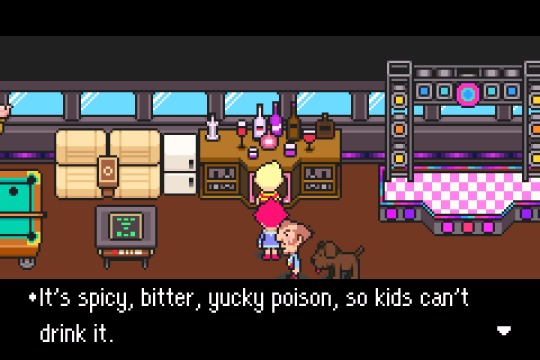
Many of Mother 3's biggest mysteries were spoiled well in advance of me ever actually playing the game. The biggest one being the reveal of the mastermind behind the game's Pigmask Army, the aforementioned Porky Minch. Mother 3 goes to great lengths to tease this mystery out across its entire 30 hour run time, dropping major hints as you pass the halfway point.
And then Porky, in his Mother 3 form, cameos as an early boss battle in Super Smash Bros. Brawl, one of the ten best selling games on the Nintendo Wii. Thanks to director Masahiro Sakurai, more people know who the final boss of Mother 3 is than have actually played Mother 3 (or, let's be honest, will ever play Mother 3).
This is why I freely mentioned Porky earlier, because if anyone knows anything about Mother 3 at this point, it's that Porky is the primary villain. The same goes for New Pork City, which was a prominent arena in Smash Bros.
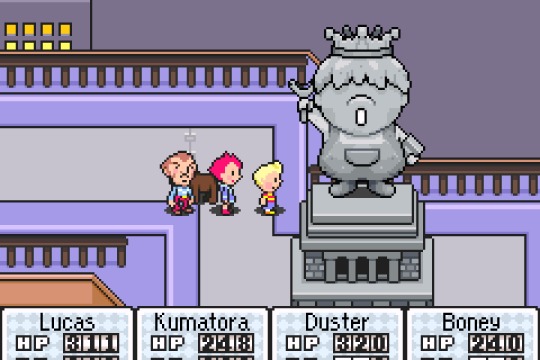
In a roundabout way, Smash Bros. was also responsible for the other major Mother 3 spoiler I bore witness to; Mother 3 pixel artwork ended up being used in other Smash Bros. games over the years, including artwork of other characters with secret identities. That hasn't stopped a number of Smash Bros. fans from casually name-dropping the true, unmasked identity of this character online. I may have avoided conversations about Mother 3, but the tendrils of these spoilers extended far beyond its humble borders. Sometimes, you just can't escape it.
This is not me drumming up any sort of "woe is me" sympathy, mind you. But ultimately, it did have an effect on me. In most of Mother 3's cutscenes, I was waiting for the big reveals I knew were coming. Expectation is everything, and when you're watching every cutscene through a microscope, it changes how you see things. There's the old adage about being so focused on one tree that you miss seeing the rest of the forest, but imagine you're so zoomed in you can't even see the one tree, and you're just kind of... stuck there.
I often wondered if my general frustration with Mother 3's aggressive tone was related to the fact I knew some of its biggest late game emotional beats 30 hours in advance.
Would its numerous Earthbound references still feel so patronizing if I didn't know what was coming? Or would all of its cute little surprises and shocking revelations make for a more enjoyable game over the long term?

Maybe the whole thing started off on the wrong foot in general. It's definitely a choice to play a game about characters processing the death of their mother while you yourself are processing the death of your mother. Characters in the game itself get bitter about this, so doesn't it make sense that I would be, too? Again, expectation is everything, and sometimes you just wake up on the wrong side of the bed. It could have just been a bad time in my life to experience this story.
And to some degree that's true, because the thing about Mother 3 is that I just didn't get it for the longest time.
Despite a big rant about spoiler culture just now, I can't talk about this without spoiling Mother 3's last big secret, because it turns out to be central to the game's entire theme. However, in my defense, I am giving you a big warning: If you've somehow read this far and still care about preserving the game's final mystery (and parts of the ending to Earthbound, too), this is your signal to turn back now.
Okay. Ready?
So while the people of Tazmily are comfortable and protective of their newly developed suburban lifestyle, past the game's halfway point they all start talking about a far off land: the big city. It's a place where dreams are made, or so they're told. And as Mother 3 starts down its home stretch, Lucas and friends return to find Tazmily deserted. Everyone who's anyone has left for New Pork City.
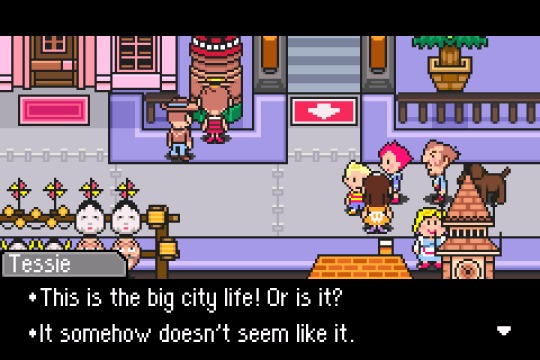
The reality of New Pork City is a lot more depressing than the dream, but then it always would be. The residents of Tazmily find it more trashy than cool. A lot of the theme park rides are broken, and those that still function are kind of dangerous. There's even open sewer vents leaking noxious gasses. And at the center of it all stands the massive Empire Porky Building.
Lucas and his friends are only allowed into the building when the time is right. Until then, you have to wander around New Pork City and explore.
Those open vents turn out to be an invitation to enter the sewer when Lucas's dog, Boney, becomes lost. Reuniting with Boney leads you to discover a secret entrance to the less glamorous parts of New Pork City, and you find yourself in an old, run down apartment complex. Though the hall is strewn with trash and grime, at the very end you find an apartment belonging to a strange man named Leder.
You initially meet Leder very early in the game. He's an older resident of Tazmily known for being unnaturally tall -- well over four times taller than most characters in the game. And to most people living in Tazmily, Leder is known to never speak. His only job is acting as a human watch tower, armed with a bell to be rung when there is danger.

Leder's apartment in New Pork City is reasonably sized for a single person, with two floors, but for a man of his stature, Leder makes the space look tiny. However, by climbing up to the second floor, Lucas can now finally talk to Leder face to face for the first time. As it turns out, Leder can talk, but by being so tall, most people couldn't hear him. Not that it mattered much, given Leder had taken a vow of silence in order to protect the true origin of Tazmily Village. Given the circumstances, and considering Lucas is old enough now, Leder believes it is finally time to learn the truth.
The truth being that despite Mother 3's outward appearance of taking place in a fantasy land full of dragons and chimera, it is in fact a distant future earth. Or, well... what's left of it.
According to Leder's retelling, after bracing itself for the apocalypse, humanity finally found itself at the end of the world as we know it. Facing mutually assured extinction, a select group of individuals boarded something known as "The White Ship" and traveled to the furthest, most secretive location on earth in order to escape destruction. Once they arrived at this mysterious island, those people used a device to erase the memories of their past lives.

The idea was to start over from scratch, free from the bonds that lead to the destruction of the old world. And so, the simple farming village of Tazmily was born. It is very likely that Lucas is one of the first generation of people born and raised in Tazmily.
For years, Leder not only kept watch over Tazmily Village, but over its people, as well. Entrusted as one of the only people who knew the truth.
Tazmily Village was a success. Its people lived in peace and prosperity, free from greed and power. However, one day, a man named Porky appeared. Porky was not from this world -- not from the old world, and not a part of this new one, either. Using the Phase Distortion machine from the end of Earthbound, Porky had been carving a swath of chaos through all of time and space. Having been defeated and ejected from pretty much every other reality, Porky eventually found himself here: the last, most defenseless place on the timeline.
With nobody around to tell him no, Porky set about treating the island like his own personal playground. He used the Phase Distortion Machine to pull in creatures from alternate dimensions, he used forbidden science to establish an army and build factories. And, once Porky became aware of Tazmily and the truth of "The White Ship", he made it one of his goals to restore their memories and further exploit their desires.

Leder's story recontextualizes all of Mother 3. It's not a game about people being corrupted by modern society; instead, it's a game about people being unable to escape it. That, despite their best efforts to run away from it, forget about it, and start over, who they are still catches up to them. When the residents of Tazmily brand Lucas as a traitor, they aren't doing it drunk on their shiny new toys, it's more that their old habits are re-asserting themselves. Not a people being corrupted, but a people who simply had their existing nature freed. Human beings acting like human beings.
This recontextualizes Porky's role in the story, too. More than being the harbinger of nostalgia, Porky takes advantage of Tazmily's amnesia to rewrite history to his benefit. His shrines to Earthbound memorabilia are less about making us remember what happened in the previous game and more about establishing his version of events, where he can refer to Ness, Paula, Jeff and Poo as his "precious friends" instead of what they actually were: the band of kids that stopped him from bringing about the eradication of the known universe.
Instead of shunning the past, Mother 3 is telling us that not only is running away from our history impossible, but in trying to do so, we open ourselves up to an even worse and easily exploitable weakness where guys like Porky get to catalyze their twisted version of history. Only by moving forward, unafraid, with courage and the full knowledge of where we came from, can we create a truly better world. We cannot bury who we used to be; we must accept and grow beyond it.

There is no stronger denouement to this ideal than the game's very, very end.
All throughout the game, Lucas has dealt with two of Porky's highest ranking officers. The first one being Fassad, who brings commerce and greed to the people of Tazmily. The other one, someone I haven't really mentioned until now, is only known as "The Masked Man." Mother 3 pits The Masked Man against Lucas as sort of a rival -- he's one of the small handful of humans you meet able to use PSI abilities, and most of them are identical to what Lucas can do.
In the lead up to actually meeting Porky in the flesh for the first time, Lucas finally catches up with his dad, Flint. Lucas hasn't seen his father in years, not since the incident after their mother's funeral that broke up their family. And yet Mother 3 treats his reappearance as strangely casual. There's no big, emotional reunion. Flint and Lucas barely even acknowledge it. Flint is just here now, another NPC milling about with the residents of Tazmily.
On the way to the final showdown, Flint will suddenly ask you to stay behind. He plans to face Porky alone.
And this is probably supposed to raise all kinds of strange questions. Could Flint be the Masked Man? After all, if Lucas has PSI abilities, maybe that's a trait that runs in the family. Maybe he inherited it from Flint, and that's why The Masked Man has all the same abilities.
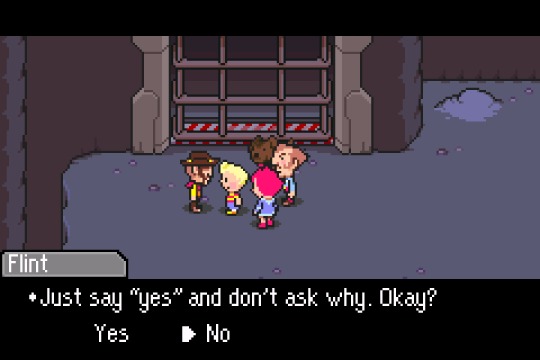
But just one or two rooms later, you find Flint completely laid out. He faced Porky and The Masked Man and came away defeated. It now falls on Lucas and his friends to stop them. Before Lucas leaves, Flint offers one more piece of information for us: The Masked Man, the rival Lucas has faced almost the entire game, is actually his twin brother, Claus.
Once Porky is successfully dealt with, the final battle of Mother 3 comes down to brother versus brother. Claus, the boy who ran from his tragedy, and Lucas, the hero, the boy who became a stronger person by overcoming that tragedy.
That's it. That's everything Mother 3 is trying to say. It doesn't get much clearer than that.
Watching the credits roll, I couldn't help but think back to earlier in the game. There I was, having just arrived in New Pork City, and I was talking to my friends about how it had taken me close to three years to finish Mother 3. I'd only play the game in fits and starts because I didn't really like it, but I was forcing myself through it anyway.
One friend told me, "If you haven't enjoyed the first 25 hours, then it's not like the last five or ten is going to change your mind."

It really cannot be understated how talking to Leder completely rewrote my entire perspective on this game. But then you also have to wonder: how many more people were in the same boat I was and didn't keep going? People who got fed up with feeling like the game was bitter and patronizing and just gave up?
I knew there must have been something special in this game. You have to figure that, given the circumstances (sequel to a 10+ year old RPG, only released in Japan), total lifetime sales figures for Mother 3 are probably under five million copies. Probably under two million, if I'm being honest. That's still in the realm of success, especially for 2006, but Nintendo is also a company that deals in games with 20 million, 40 million, even 60 and 80 million plus sales. Mother 3 is some very small potatoes for them.
Despite such a comparatively modest success, Mother 3's influence feels hard to ignore. From fueling skits on Robot Chicken to Adventure Time and Undertale's whole... everything, Mother 3 (and the wider franchise as a whole) is extremely beloved by many, even if it doesn't do record breaking sales numbers.
And that's before you figure in the whole fan translation angle, too. Everything about Mother 3 screams something that should be niche, and yet it's downright prolific.

It demanded more respect than giving up before seeing the credits roll. If I had quit upon reaching New Pork City, I would have missed this game's whole redemption arc.
I suppose, then, that just makes this the chronicle of a long, difficult, emotional journey. One I originally felt like I needed to do more than I actually wanted to. That in itself is just another one of those many things adults just have to deal with, right? That's in keeping with the themes of the game.
And, ultimately, there is light at the end of this tunnel. I guess it's not really about charging forward with courage, it's more that as long as you hold on to yourself, everything will be okay. Everyone has their tragedies. But closing yourself off from tragedy or running away from it isn't going to fix you. Your love is what will save you.
The love you share with family. The love you share with friends. The love you share with the world.
Love meant Flint never gave up trying to save Claus, even as that same boy tried to kill him.
Love led Kumatora, Duster and Boney to stay with Lucas no matter how strange or frightening things became. Together, they faced deadly mutants, the darkest hallucinations, and even had to contend with the possibility that all human life on their planet might cease to exist.
Love was Lucas never abandoning the people of Tazmily, even as they shunned him.
Love will provide you with a strength beyond anything else in this universe. No matter how much adult life beats you down, love will always be the single greatest and most simple thing we all have. Rich or poor, old or young, love is the power that binds us all. It deserves to be cultivated, protected, and celebrated. Love heals all. Without it, we cease to be human. And believing in love is what takes the most courage.
But only through love can we find the way forward.

49 notes
·
View notes
Text
youtube
So, here's some simple thoughts I had about Sonic x Shadow Generations. I was trying to push this one out real fast, but ended up with some technical problems and other stuff you can read about below the cut.
This video was a small technical nightmare to put together because I'm experimenting with new stuff. I capture a lot of my own footage when I can, and when I can't, I go out of my way to find the cleanest, highest quality version of what I'm looking for. That in itself can take a lot of time, but then I usually have to download it off of Youtube. For years, I've used a suspicious website called Keepvid (don't go there) to download Youtube videos, but recently I saw someone recommend a piece of software called "Stacher".
Stacher is basically a front end for another piece of software called "yt-dlp", which was the subject of a lawsuit a couple years ago -- basically, Youtube (Google) was claiming it was illegal to download Youtube videos, and was specifically targeting yt-dlp in the hopes of getting rid of it. A judge ruled that downloading Youtube videos is in fact totally reasonable and legal, and yt-dlp was allowed to keep existing. All of this is because yt-dlp is the best way to download Youtube videos, but it's command line software. I'm no stranger to command line (I've used FFMPEG), but I do tend to prefer having an interface to work with, which Stacher provides.
I picked up Stacher because Keepvid was starting to not work so well. Youtube is implementing new video formats and Keepvid was consistently only detecting 720p30 downloads. Stacher on the other hand will grab the absolute maximum possible resolution, which in this case was 4K60. Which is great! Even though I am downsampling to 1080p60, it still means I'm getting very sharp, very clean source footage. Except Vegas doesn't really like whatever 4K60 format Youtube is using, so I have to transcode it using Handbrake, which for even a 10 minute video can take upwards of an hour.
And then there's editing. My poor little 2015 CPU (Intel Core-i5 4690K) really struggles to work with 4K footage, which probably doubled the length I spent in Vegas putting this together. On top of the hours spent transcoding. So you can really start to see how all this adds up and delays what should have been out by, like, the 12th.
And if I couldn't get it out fast... I do wish I'd spent maybe a little longer explaining some of my opinions. I get the gist across but in particular when talking about what I think is cool about this level design, I think I could have explained a bit more.
Sonic games make you feel so railroaded and there are little hints in this footage of breaking free of that. There's a bit in the footage we've seen where Shadow runs around inside of a tube. This is interesting because:
This is a level design feature that makes total sense with Sonic style physics
This is a level design feature they barely ever use
There's an alternate path where, if you're fast enough on the draw, you can take a grind rail on top of the tube.
Not only would most Sonic games never have this tube section at all, if they did, they would not let you skip the tube and run on top of it. And if you go on top of the tube, there's more than just one grind rail up there, to boot!
So I see something like that, and it gives me a different vibe than most 3D Sonic games typically get. And that makes me excited!
As always I think these work best when I take a step back and think a little. Better Late Than Never is my brand.
#sega#sonic the hedgehog#sonic team#sonic x shadow generations#sonic generations#remaster#shadow the hedgehog#video#youtube#reaction#Youtube
9 notes
·
View notes
Text
A Better Late Than Never Look at "Knuckles"

Note: I get pretty casual with spoilers as I go.
So after consuming 5 out of 6 episodes of the Knuckles show when it was new, and then waiting two weeks (I was busy with other things!) to watch the finale, I think I'm finally in a place where I can talk about how I felt about it.
From the earliest adopters, I'd heard that this show was trash. Some went so far as to call it one of the worst things in the Sonic franchise, period.
It's not the worst thing in the Sonic franchise. I don't even necessarily think it's bad. But I would also struggle to call it good. It's... a little more nuanced than that.

The story brings us back to Knuckles the Echidna in the weeks following the end of the second Sonic the Hedgehog movie. Having helped in the defeat of Doctor Robotnik, Knuckles finds himself restless. He's a big mish-mash of different barbarian, viking, and warrior stereotypes, and he can no longer quench his thirst for combat, something that's starting to drive his friends crazy.
Knuckles convenes with the spirits of his ancestors (Pachacamac, played by Christopher Lloyd) and learns he must take on an understudy and train them in the ways of the warrior, much like his father did with him. However, we also learn that Knuckles is now the last of his kind (something the movies never elaborated on, I don't think) and thus his understudy has to be someone from outside his species.
Pachacamac tells Knuckles to seek out Wade Whipple, the dopey deputy of Green Hills, Montana, and educate him in the ways of the ancient Echidna warriors. Wade recently lost a bowling tournament to a particularly snarky 8 year old girl scout, and so Knuckles and Wade go on a road trip to the National Bowling Stadium in Reno, Nevada so that Wade can reclaim his title, conquer his battleground, and become a true warrior.

Right away, there's a lot wrong with the Knuckles series, and most of it happens in the first three episodes.
Though we should be used to it by now, how fast and loose the movies play with Sonic game lore is pretty annoying. In the years since that second Sonic movie, we've seen the release of the Super Mario Bros. movie, and while that's not exactly a perfect movie in itself, it is maybe one of the most faithful and respectful game adaptations ever released.
The Knuckles series building a twisted Frankenstein of Sonic game lore now feels increasingly frustrating by comparison, especially as it rewrites the movie's own history in order to borrow from the more story-heavy games. The first Sonic movie shows us a whole tribe of Echidna warriors trying to capture a young toddler Sonic for unknown reasons. Though it's been almost two years since the last time I saw it, when Knuckles is introduced in the second movie, I don't think it's ever mentioned he's the last of his kind. We just know he's looking for Sonic for the same nebulous reasons the rest of his tribe were hunting him down in the first movie. The "Last Echidna" stuff comes from the games, and now it eventually gets mentioned in this series.
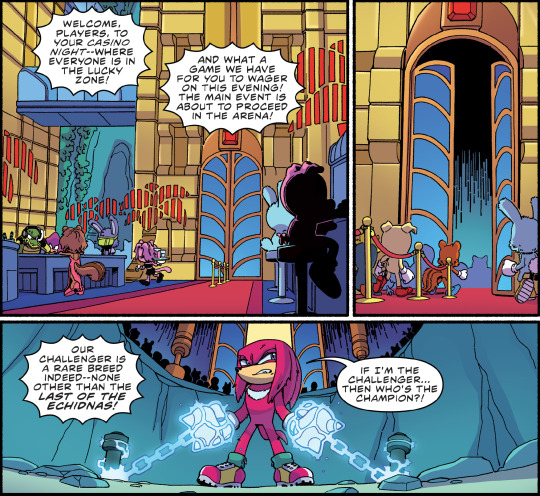
As a sidebar: I'm aware there's an off-hand piece of dialog in the Sonic 2 Movie Prequel comic that mentions Knuckles is the last Echidna, but that's a flimsy promo comic and none of it feels canon to me. That comic also has a cameo by the Chaotix and features way more Sonic environments than the movies ever will, making it feel disconnected to the actual movies.
Like it's fun, don't get me wrong, but it's also like when the Spider-man games based on the Sam Raimi movies would bring in characters from the comics, like Shocker or Mysterio. You KNEW if the movies ever dealt with those characters for real, they'd be completely different from what was in the games. The promo comic casually mentioning Knuckles is the last Echidna may as well have been nothing more than fluff for all anyone knew.
In fact, it gets mentioned in the Knuckles series that The Owl Tribe -- the same creatures who we saw protecting Sonic in the first movie -- have apparently exterminated the entire Echidna race. It's only been, what, seven years? Eight years? So what's going on there? Who are the good guys? Who are the bad guys? The Echidnas apparently wanted to kill Sonic, and the Owls were willing to commit genocide to protect him, and this all seems like some pretty heavy stuff for a series that still refuses to define what this "power" everybody has actually is.
It feels extra obnoxious considering the proximity to the upcoming Sonic the Hedgehog 3 movie, which is openly an adaptation of Sonic Adventure 2. There's more than a little Echidna lore that needs to be set up in order for parts of that game to make sense (if it ever did), and it's obvious they have little interest in carrying that forward in the movies, content instead to make up their own lore. And what we've seen of that so far doesn't necessarily seem to be better, it just seems to be different. Like they dug themselves into a hole and now have to dig back out in a different direction -- more damage control to cover for that first movie twisting up the source material.
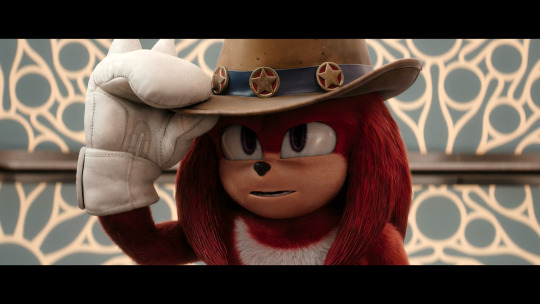
Ultimately it ties back around to the fact that I don't think this is what Sonic fans were hoping for. There were a lot of directions to take a Knuckles solo project, and they made it into a road trip buddy comedy between two of the weakest characters. Movie Knuckles is a one-note Klingon stereotype and it feels like Idris Elba is sleepwalking through a lot of this chest thumping "heart of the warrior" stuff.
And Adam Pally as Wade Whipple was okay in small doses, but he wasn't exactly breaking new ground as the bumbling small town deputy. Putting these two guys in a box together is kind of a bad idea.
And for the first three episodes, it is. Wade and Knuckles have absolutely zero chemistry together. Most shows would have a little hint that these two guys like each other, but it's more that Knuckles wants to train Wade for selfish reasons (satisfying his ancestors) and Wade is kind of a dumb puppy who does what everyone else tells him to, sight unseen.
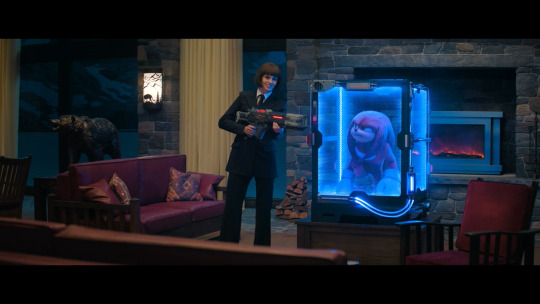
We also get new B-tier villains for our B-tier show, who swagger in like they missed the audition for their gig on Mighty Morphin' Power Rangers (no shade meant towards my sentai fans in the audience). They're GUN Agents, either current or former, and have apparently been selling weapons tech to a genuinely dangerous killer only known as "The Buyer."
Actually, another small sidebar: it was kind of strange to see Knuckles rated "PG" (for some mild swearing), but Paramount+ constantly inundate me with advertisements for Dora the Explorer, Minecraft, and The Loud House. This is actually my first, real, honest exposure to The Loud House, both in its cartoon and live action form. It feels like a show made for the whitest children on earth and if I have to see that little girl with the shrimp bowl fart again I'm going to throw my TV into the street.
Anyway, Knuckles: for the most part, the villains only really exist to remind us that this ties to the Sonic the Hedgehog movie universe while also providing goons for our heroes to fight.
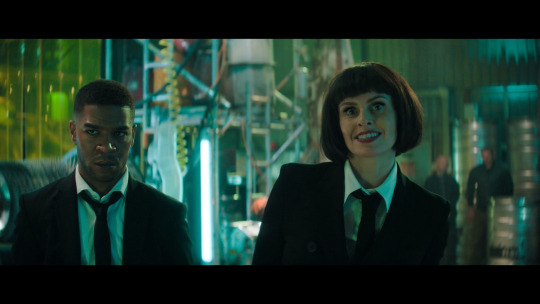
If I'm being real, I was actually a little confused by the presence of the GUN Agents. The Knuckles show is kind of bad at establishing whether they still work for GUN or not. We do get a scene where they go rogue, but it's never clear if they're just overachievers who get results, or if they are actual card-carrying bad guys who are breaking off for a solo career. I just figured they were here as a flimsy setup for the third Sonic movie.
Mostly, though, it's a lot of fluff. Knuckles or Wade gets into trouble, and they accidentally stumble out of one bad situation into another, over and over, for a good 90 minutes. Very few jokes land, it doesn't feel very funny, it's a confusing mixture of new lore and stuff borrowed from the games, and it feels like the show is a mess that's constantly spinning its wheels.
Wade, now branded as a fugitive for being seen fighting GUN Agents (again: current or former?), accidentally and conveniently finds himself at his mother's doorstep seeking asylum. On the jewish holiday of Shabbat. Now, I'm not jewish, but it seems like Shabbat can happen on literally any Friday, yet the Knuckles series treats it like an annual holiday like Christmas or Halloween. Regardless, it seems like Wade happens to catch his mother on a Shabbat where she's already preparing a big meal, since Wade's older sister, an FBI agent, also happens to be in town. Which is also weirdly convenient. Wade, feeling like he can't disappoint his mom, sits down and they have a meal together, only to be assaulted by bounty hunters looking to claim the price on Wade's head.

This episode starts a kind of turning point for the Knuckles series. Over an hour into this three hour ordeal, and it finally provides some threads of character development for Wade Whipple. We learn his estranged father is a legendary bowling champion, who will also just so happen to be at the big bowling tournament Knuckles is ushering him towards. Knuckles has a cozy moment with Wade's mother, and we learn more about how much she hates Wade's father for breaking up their family.
The fourth episode finds Wade facing down yet another bounty hunter. Earlier I mentioned Wade lost a bowling tournament to an 8 year old girl -- specifically, he lost a placement match for a bowling team known as The Renegades. The captain of The Renegades is a man known as Jack Sinclair, and when he rejects Wade's entry into the team, he casually mentions a bounty hunter gig he runs on the side. Now, Jack's back to claim the $100k bounty, and Knuckles has decided that it's time for Wade to solve this problem on his own.
Ultimately, this means Wade is forced to convene with Knuckles' ancient ancestors for himself, leading to, of all things, a rock opera in a spectral bowling alley where we learn more of Knuckles' origin. If the Shabbat dinner episode finally budged the needle a little bit, this rock opera episode is the kick in the pants this series should have opened with.
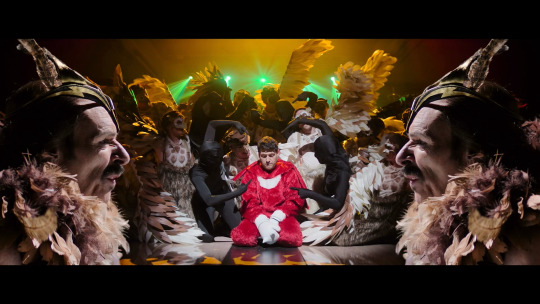
We get Wade in a Knuckles costume, a puppet of Knuckles' dying father that's definitely a reference to Archie's controversial Sonic writer Ken Penders, dancers in owl costumes, and a genuinely impressive prop of a "Fire Demon" (Iblis from Sonic 2006) operated by an entire squad of bodysuit actors. It's a lot of fun and I even found myself starting to laugh at the jokes! It only took, what, two hours?
As the rock opera explains, after Knuckles watched all of his friends and family get slaughtered by the owl tribe, Knuckles wandered the galaxy, hopeless. Knowing he was the only one who could protect the master emerald, he challenged this fire demon to claim the power of The Flames of Disaster. The demon nearly killed Knuckles, but by keeping the warrior's spirit in his heart, he summoned the strength to defeat Iblis once and for all and claim The Flames of Disaster as his own. Thus, Wade learns that a warrior's true strength comes from within, giving him the push needed to have a final showdown with Jack Sinclair.
And then something else weird happens: the final two episodes of the show turn into something completely different.
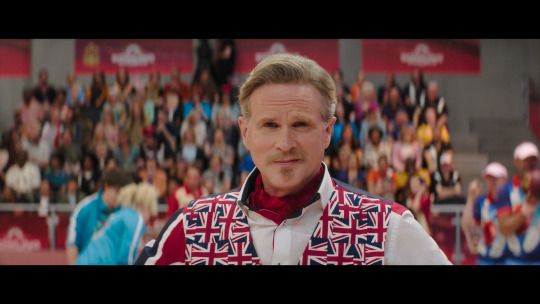
In my opinion, the more the Knuckles show gets away from Knuckles himself, the better it gets. Even though I thought the rock opera origin story was great, the less we have to worry about their jumbled up lore, the better. And these last two episodes of Knuckles get about as far away from the Echidna as they can get, turning into a late 2000's sports comedy in the vein of something like "Balls of Fury", "Hot Rod" or "Blades of Glory." Except here, the stand-in sport of choice is bowling.
It's actually pretty funny how much the previous four episodes just stop mattering entirely. Like, the bounty on Wade vanishes. Being a wanted criminal (former or current) has no bearing on his ability to attend the bowling tournament despite apparently being national news not even 48 hours earlier. It's never mentioned or brought up again.
Knuckles almost exits the show entirely. He spends most of the final two episodes relaxing in a hotel room, leaving Wade to carry almost literally everything else by himself. We get introduced to Cary Elwes as Wade's father Pistol Pete, who summons the same level of ham and cheese we last got from him in Robin Hood: Men in Tights.
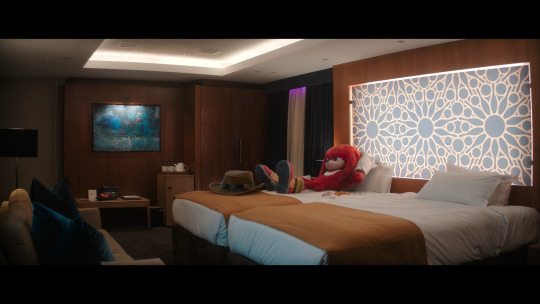
And... It works. It's not the greatest thing on earth, but compared to where this show started, once the bowling tournament kicks off, it's literally the best part of the whole series. The jokes get even funnier. We get all these different themed bowling teams, everybody in special costumes, with dumb names like "Ball Busters" and "Split for Brains." The editing gets really energetic and creative, too, with lots of flashy split screen cuts set to music.
It feels like somebody had been sitting on a decade-old bowling comedy script and dusted it off for these last two episodes. It stops being the Knuckles show and starts being the Wade Whipple show, and is surprisingly better for it.
But then, that's not entirely true. It's still the Knuckles show, and almost begrudgingly, they have to make up a reason for Knuckles to have a big fight at the end. It's almost funny how blatant it is -- there's so much focus on Wade's showdown with his Dad that when they cut back to Knuckles it feels kind of forced. Like they realized Wade is getting all of the pathos and character development but they still needed to show Knuckles doing something, anything, so here's a big robot that needs punching.
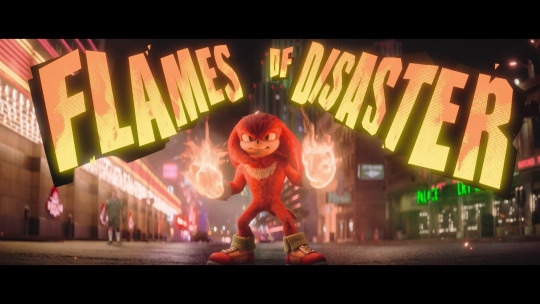
It's not terrible, and Wade eventually joins him, tying into his overall journey of believing in himself and becoming "a warrior", but it does feel kind of tacked on regardless. There's this general vibe of the show getting lost in the bowling tournament and then going "Oh, right. That guy."
Listen, I'm not here to evangelize this show. It's kind of an inconsistent mess. It's jammed full of obnoxious needle drop musical interludes, there's tons of REALLY blatant product placement, and just like with the previous two Sonic movies, whenever it makes direct references to game lore, it feels more pandering (and increasingly sloppy) than anything else. It takes its sweet time expanding on both its title character and his poorly chosen side kick. A lot of it made me cringe more than laugh.
But it does eventually hit a stride and I'd be lying if I said I didn't enjoy the back half of it. You can really see the show start to find its footing once you hit that Shabbat episode, and by the end of the rock opera, Knuckles had finally won me over... by getting further and further away from Knuckles himself.
And... that's not really a great endorsement, now is it.
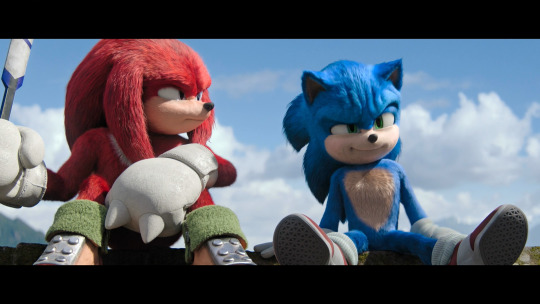
#writing#paramount+#knuckles series#knuckles show#knuckles the echidna#review#thoughts#idris elba#sonic the hedgehog#sega#sonic team
29 notes
·
View notes
Text
I Love To Shoot At Trouble

During the Steam Christmas Sale I ended up buying Need for Speed: Most Wanted 2012 because it was like $6 or $7 and I'm in the mood for a new racing game to chew up. EA already gave the game away for free in like 2015, but that meant installing "The EA App". I figured having it on Steam would be more convenient.
You'd think so.
It's not! As part of the first time launch, it installs "The EA App" anyway, which also means it found and uninstalled whatever version of Origin I still had (I wasn't aware I'd ever reinstalled Origin since my HDD crash). As part of this process, it also asked me for my EA password, I misread Firefox's stored password incorrectly, and went through the trouble of resetting my EA account with a new password before linking it to Steam. To my surprise, EA's been sitting on my seven year old cloud save from the few minutes I played of this on Origin in 2017, and asks if I want to import it. Sure, I guess.
So that's ten minutes down the drain before I can even boot up the game. Okay, fine, the game finally launches. Gotta wait while it boots up The EA App each time before it boots into the game, gotta wait for the title screen logo animation, gotta wait for a 10-15 second load screen because even though this game came out in 2012 it's gotta ping some always-online "Autolog" leaderboard whatever. Once it connects, it has to do a slow cinematic pan across your car, telling you what your online rivals have done since the last time you connected, and what kind of equipment you have on your car.
All told, every time you boot up Most Wanted 2012, you're looking at a 30-45 second wait before the game actually hands over control and lets you start driving.
Pull the accelerator and instantly Most Wanted SCREAMS at me:
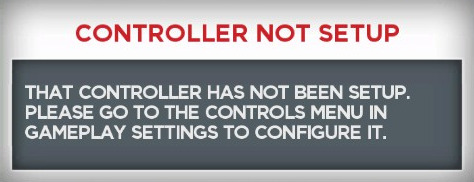
Fair enough. I'm using a Dualshock 4, and the Playstation 4 did not release until over a full year after this game. Click to the menu it's asking of me and see that the control binding menu is awful -- it's one of those super oldschool ones, like binding keys one by one in Doom 2. I have no idea what these buttons are supposed to be in terms of Xbox equivalents, and I realize that Steam has this thing called "Steam Input" that's supposed to be handling all of this anyway. Steam Input generally makes my Dualshock 4 look like an Xbox controller to most games.
I exit out of Most Wanted, force Steam Input to "on" (I was messing with its settings recently, so I thought maybe it was disabled), and relaunch the game again. Wait for the EA App to boot up, gotta wait through the title screen logos, gotta wait 10-15 seconds on a loading screen, gotta wait another 5-10 on the cinematic pan across my car. I have now spent a minute and a half total waiting for this game to boot while I troubleshoot this.
Pull the accelerator. Instead of it complaining about my controller, straight up nothing happens. That's weird. The Start button works, the analog stick seems to work in the pause menu, but the triggers do not. The face buttons also do nothing. Upon checking the settings, that's because Most Wanted has settled on keyboard mode, even though it's clearly accepting some controller input. After poking at it, it does not seem like there's any way to get it to see my controller.
This makes Most Wanted a special game, because a lot of games I play will happily accept that Steam Input is telling it I have an Xbox controller connected even when I absolutely do not. But this is the rare 1% that seems to be incompatible. It's time to bring in the big guns.

Mayflash makes a terrific little passthrough device called the Magic NS, and the general purpose of this device is that it lets you use any controller on any other platform. An Xbox controller on a Playstation? No sweat. A Playstation controller on the Switch? It'll handle it. If you upgrade to the Magic NS2, you even get full gyro support. Every NS device also doubles as a Bluetooth dongle, so you can stay wireless if that's your thing. I love it so much I bought two, because generally they're only about $20.
A Magic NS2 for my Switch... and Magic NS1 for my PC. Strictly for scenarios like this, where a game expects an Xbox controller and Steam Input fails its camouflage.
Plug the NS1 in, connect my Dualshock 4, and once again boot up Most Wanted and wait the 45 seconds to get through the EA app, logos, loading, and the cinematic pan across my car. More than two full minutes now looking at this junk, and that's not counting the time spent outside of the game troubleshooting this in menus or digging out dongles or whatever.
Pull the accelerator... and my car starts to drive! I can steer! It works! Of course it works. The Magic NS never lets me down. I pull up to the first race event...
Press J and K to start the event.
Those are, uh. Those are keyboard keys. I'm using a controller. The controller is fully functional. You don't need to tell me this in keyboard controls. This isn't going to be one of those games, is it? The kind that still tells you everything in the keyboard shortcuts no matter what?
I drop into the menus again and see Most Wanted is still stuck on Keyboard mode and won't let me switch to anything else, even though I'm clearly using a fully functional controller now. This can't be right. But then I remember: Steam Input is still turned on, and when I forced Steam Input to be on, Most Wanted got stuck in this keyboard mode.
Exit out of the game, tell Steam to turn off Steam Input for this specific game only, and relaunch. Wait through all that crap again. We're up to three minutes just waiting for the game to start, and probably closing in on 20 minutes since I first decided I wanted to try Most Wanted.
Pull the accelerator, it works, drive up to the first event, and...
Pull LT and RT to start the event.
FINALLY. HOLY SHIT.
On the plus side: this game controls a lot better than I remember. It's a decent middleground between Criterion's heavier-feeling Hot Pursuit (2011) and the snappier Burnout Paradise. Though I could do with a lot less full screen flashing or the fact that Autolog alerts hide the minimap for some reason.
youtube
Not pictured, but the "always online" nature can also be frustrating if you pause, unpause, and find you have to quickly re-pause again a second time. That second pause will actually incur a loading spinner because it hasn't finished syncing with the server from the first pause, apparently. This game is going on 12 years old.
Anyway. This was a nightmare.
HOT BONUS
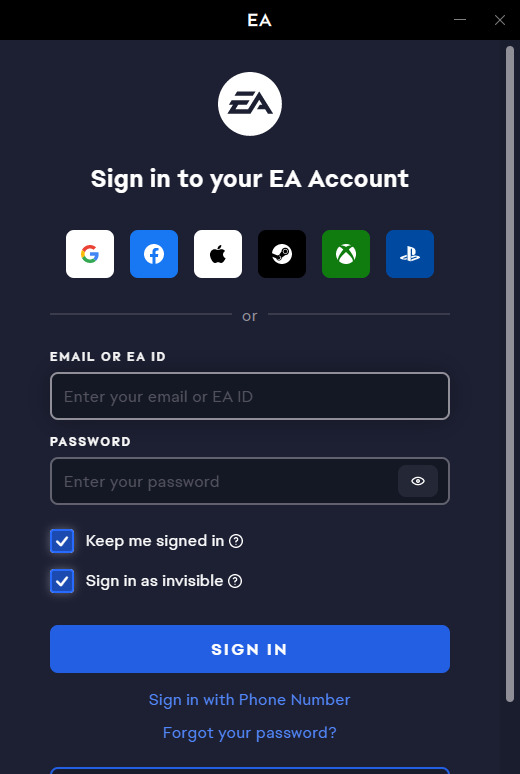
"The EA App" now starts up with Windows and is nagging me to enter the login credentials I already entered last night. I have to go through extra steps to get it to leave me alone and not do this
THE RIDE NEVER ENDS
#need for speed#most wanted#criterion games#ea#electronic arts#origin#the ea app#steam#valve#xbox#steam input#troubleshooting#mayflash#Youtube#writing
39 notes
·
View notes
Text
Mod Spotlight: Sonic Forces Overclocked
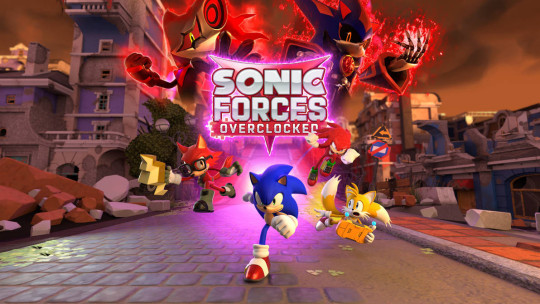
So this is an interesting little thing. For those of you not aware, Sonic Forces Overclocked (if I'm remembering right) was originally an attempt to "fix" Sonic Forces by expanding all of the levels and even completely rewriting the story. Obviously that's a big task, and the developers eventually realized that, scaling it down into what could best be described as an "Encore" of sorts -- an epilogue story where the villains make one last desperate final push, spread out across remixed versions of eight of the game's best levels. All told, it's about an hour worth of content.
Which is... actually totally fine. With eight (technically seven, but the final boss still counts) levels, there's plenty to see. Actually, pacing is probably Overclocked's strongest suit.

The original Sonic Forces was a pacing disaster; levels often felt like they were cut off at the knees, usually ending just as they were getting started. That's never true in Overclocked, as each level took me a good 3-5+ minutes to finish. Levels in Overclocked are also massively improved in other ways, too -- all that extra length is put to good use with Sonic's trademark alternate pathways, new enemies, and new interactive elements. Interactivity is up across the board. Sonic Forces loved to lock you into long, obnoxious scripted set pieces but Overclocked keeps you firmly in control most of the time.
Which brings me to something I'm not entirely sure is a complaint: difficulty balance. If you've been reading this blog long enough you know I can be pretty picky about difficulty balancing, and the way its handled in Overclocked is interesting.
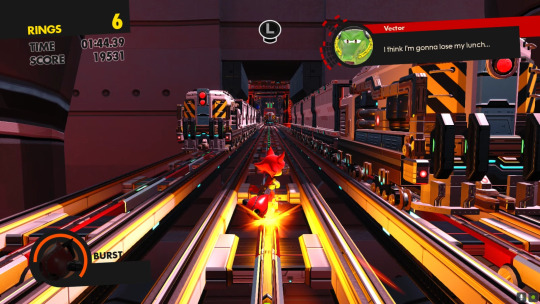
Generally speaking, Overclocked treats the boost like "expert mode." It's there for people who know the levels already and want to push themselves to do it faster. At first it's fine -- boosting means you'll miss some alternate paths (shortcuts, most likely) but you can still bumble your way to the end of the level and coast by on C ranks. The further you get into the game, though, the more it starts to punish you for trying to go fast without knowing what you're doing. The safety nets that would catch you in earlier levels go away and Overclocked tells you to either slow down or get serious.
Which... I think I'm fine with? The thing it brings to mind for me is the two Sonic Rush games. My favorite one is Sonic Rush Adventure, because it's more accessible (read: easier to learn) than the first Sonic Rush. At the same time, the first Sonic Rush ends up being the more replayable of the two games, because it's a lot harder to master. The higher skill ceiling has kept me coming back to Sonic Rush long after it felt like I wrung all of the gameplay out of Sonic Rush Adventure.
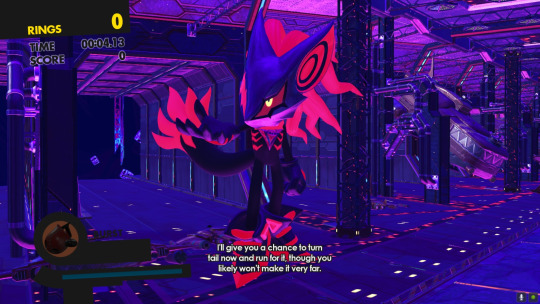
So the idea of a Sonic game not only facilitating a higher skill ceiling but maybe even encouraging that? Not the worst way to balance things, as long as you keep the less skilled players in mind and communicate things correctly. Which, at least for me, I feel like Overclocked does. It started to kick my butt at certain points, but never in a way that felt too mean or unfair. And that's exactly the way it should be, though it should be noted I haven't exactly put myself through the hell of trying to go for higher ranks.
The one real complaint I have about the levels is something I've been observing for years, and unfortunately my fears came true: the lighting.
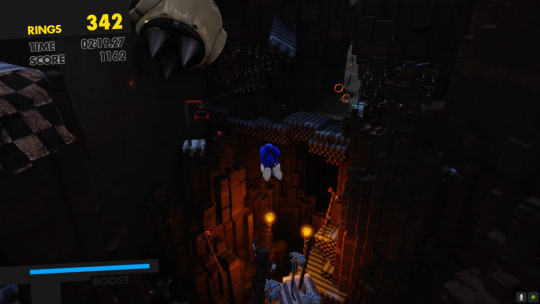
I've talked about my monitor in the past. I bought it somewhere between 2011 and 2012, so it's getting up there in years. I believe it was the first thing I ever purchased with my Youtube Earnings. It's starting to get kind of dim in its old age, and it's exacerbated by the fact I like to keep it on its "Theater Mode" setting, which gives me really good black levels (for an LCD) and amazing color. But it's an aging monitor, so those amazing black levels end up feeling a little dark, depending on the game. For those of you who caught my halloween streams this year, you know I ended up switching my monitor to its "Standard Mode" because it flattens the contrast and makes the darkest darks more visible. It could be argued that I should just leave the monitor in "Standard Mode" at this point, but I can't stand how Windows looks with it turned on.
To cut to the chase, I had to turn on "Standard Mode" for Sonic Forces Overclocked. In keeping with the theme of this being an encore, a lot of levels have wildly new lighting applied to them, with many levels set later in the evening or at night.
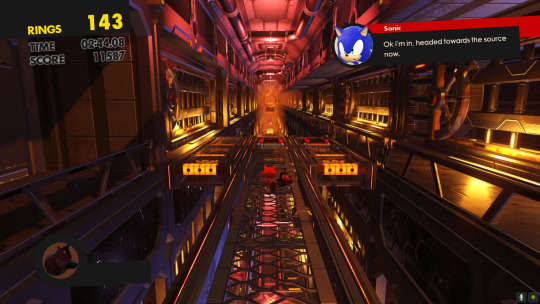
This blankets a lot of levels in a single color and lots of high-contrast shadows, which makes character, enemy, and hazard visibility incredibly difficult. In some levels with a lot of high-frequency noise (like Chemical Plant) it can be difficult to tell where your character even is on screen sometimes. In other levels, like the revamped Mystic Forest, the blue-on-purple-on-teal color scheme makes for a readability nightmare (as does the Death Egg Core level with Buddy, with a red character navigating a level full of orange fog, lit by pink and yellow lights).
When you're running through these stages at a couple hundred miles per hour, it all blurs together into something that's sometimes either too dark or too muddy to parse. At one point Sonic jokes that Infinite's aesthetic is "monochrome colors" but I'd rather have the levels be readable at a glance than hanging a lampshade on it. Things just need to be a little brighter, with a little more diversity of color to highlight the edges of roads and incoming hazards.

The story is... fine. It's not incredibly deep, and it doesn't need to be, so it works well enough. There's actually a surprising amount here, though, from mid-level chatter, map screen debriefings, and even full on cutscenes. Voice acting duties seem to be handled by Adrenaline Dubs, who I subscribed to last year for their surprisingly good dubs of Archie and IDW Sonic comics. They turn in some pretty high quality work here, often rivaling Sega's official dubbing efforts. My only real complaint is that Sonic's dialog is a little too referential; his call-outs during levels often reference other infamous lines from different Sonic games ("The whole city's on fire!", etc.), and sort of like how the game pokes fun at the monochromatic lighting, there's a line where Sonic even cringes at his own dialog a little bit. "We're admitting it's bad, but still doing it anyway" is not a healthy design ethos.
Earlier I mentioned cutscenes, and rather than the complex, high-budget cutscenes Sega had in the original Forces, Overclocked instead opts for motion comic videos. Artistic duties for these cutscenes are shared between a handful of 4 or 5 different artists, each bringing their own art style to their scenes. Generally, I think this is a good move. A little more consistency between artists would make it feel a bit more polished, but seeing the art style change between scenes has its own charms, too. It really drives home how much of Sonic Forces Overclocked was not only a team effort, but to some degree, a community effort. Many different hands touched this project, and it is better for it.

It's easy to focus on the negative things I said about Sonic Forces Overclocked here and think I came away not really liking it. Nothing could be further from the truth. I think this is a genuinely impressive mod, with significantly better level design than the base game. It has a few problems, sure, but the overall product, when taken as a whole, is absolutely wonderful. This might be a bit incendiary and hyperbolic, but this close to the top of the list as the most fun I've had with a Sonic game this year. If you own Sonic Forces on Steam, it's not to be missed.
Download: https://gamebanana.com/mods/485051
45 notes
·
View notes
Text
Let's Talk About Fortnite's Big New Update
It's been about a week since Fortnite added its three new main modes, so I figured I could jot down some notes about how I feel about each one, since I continue to play an absolute obscene amount of this game, given it's basically the only live service game I've ever connected with.
Lego Fortnite

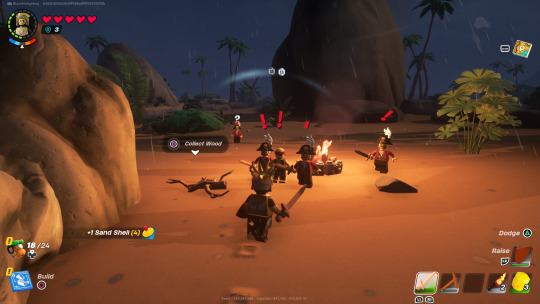
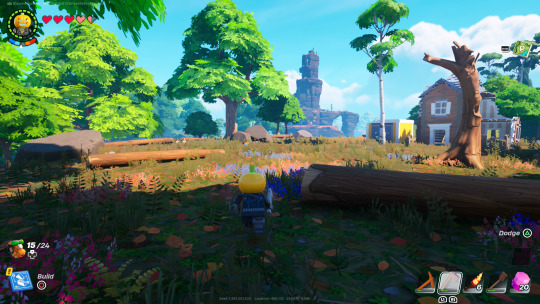
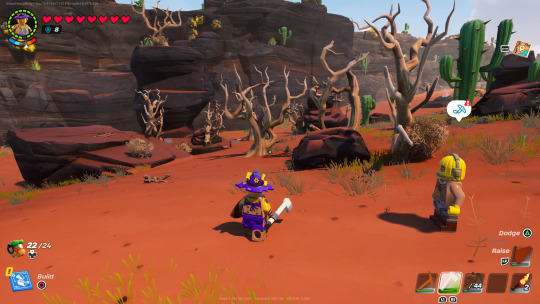
This is maybe the biggest new mode added to the game, and at a glance, you might think it's their take on Minecraft. Having put about 10-20 hours into it now, I can tell you it's a lot more like Valheim, sprinkled with a bit of Terraria. It's a survival game, where your goal is to start a town out in the procedurally generated wilderness. As your town levels up in size and complexity, you attract NPCs to take up residence, which you can put to work gathering resources, manage farms, cook food, or party up to help you explore the world and raid various caves.
There's enough content here to support that 10-20 hours, but you'll eventually run out of things to do, given there's just three biomes and only a handful of creatures. Updates are already promising things like merchants, more creatures and even quest givers, so it definitely feels like it has legs, and I think what's here plays well enough. It just feels more like a foundation right now. This is one of those things where, like, it may be worth checking in on 6 months down the road, because there's a lot of potential it could grow into. And hey, it's the only one of these modes that doesn't have any additional fees hooked on top of it yet. That's a plus.
Rocket Racing
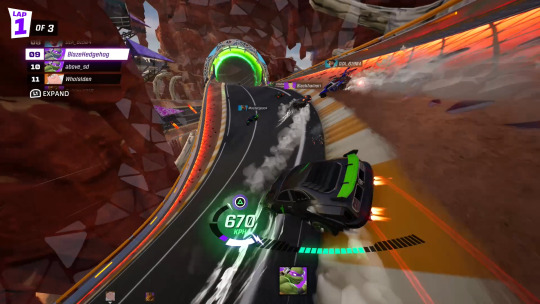
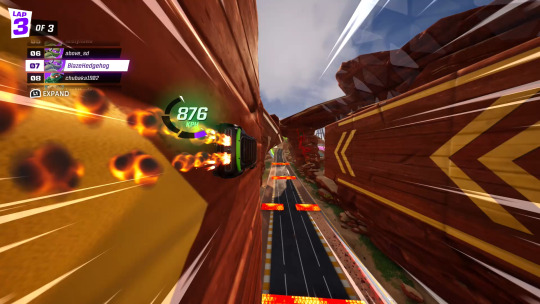

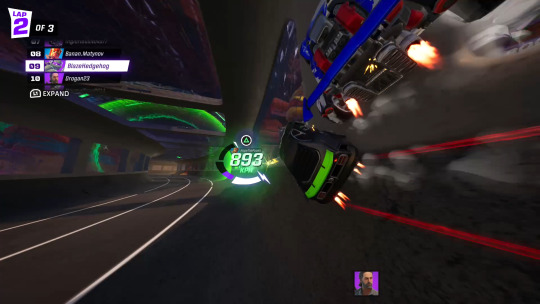
Created by Psyonix, this is a racing mode that's a little hard to quantify. The actual racing mechanics themselves are solid: drift to charge up three levels of boost, with a kind of "active reload" system that can almost double your boost if you hit it just right. There's a jump button, and your jump jets can be used to hover over hazards. After you jump, you can also use the drift button to perform a flip in four directions, because your car can also drive up walls and across the ceiling. So, if you jump, push up on the stick, and then tap the drift key, you'll flip up on to the ceiling. Despite all of this mechanical complexity, Rocket Racing still feels too simple to have much lasting power. Some of the fun of a racing game is how everyone tunes their vehicles differently, but so far there's just the the one Rocket Racing car.
Epic and Psyonix could be going for more of a Trackmania feel, and user-generated tracks (the main appeal of Trackmania) are something they're teasing for Rocket Racing, but it's worth mentioning that Trackmania has always seemed kind of niche. It's never had the success of something like Forza Horizon or even Need for Speed.
This also has one major strike against it that Trackmania does not: you collide with other players in Rocket Racing, which is actually sort of a nightmare thanks to network latency. I've run into a lot of shockingly aggressive opponents that treat the game like bumper cars, and every time they crash into you, it's like rolling the dice as to whether or not the collision will actually register. Sometimes your opponent harmlessly slides off the side of your car, and other times the most gentle tap will send you into a tailspin. I wouldn't call the mode terrible, but judging by Fortnite's own menu system, player numbers are dropping fast. It's cool being able to flip around between walls and the ceiling, but there's not enough to sink your teeth into long-term besides overpriced vehicle cosmetics.
Fortnite Festival


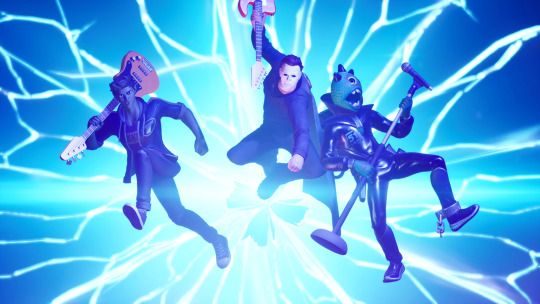
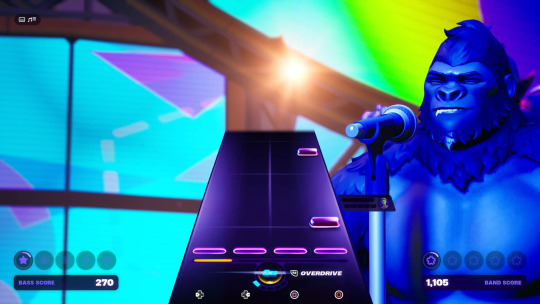
This is literally just Rock Band 5. The main change is the way you play notes -- there's no plastic instrument support yet (that's coming later, apparently), so you're limited to playing it on either a keyboard or a gamepad. The way the buttons are mapped out by default, there are certain combinations of notes they are never going to make you press together, because it's impossible to hit both left and right on the d-pad simultaneously. Besides that, I'm not kidding, it's actually just Rock Band, and unfortunately I'm one of those people who struggles to connect with rhythm games.
I love something like Parappa the Rapper or even Theatrhythm, but I just don't connect with a lot of the genre in the same way most people do. This version does at least connect to Fortnite's cosmetics system, so you can have Michael Myers singing vocals in Gangnam Style, backed up by Beast Boy and Ellen Ripley wearing a Ghostbusters proton pack. During downtime where you might not have any notes to play, you're given the option to use your Fortnite emotes. That's fun enough on its own, but it's extra fun on skins with transformation abilities. Going back to Beast Boy, it's fun to watch the camera pan by him in his regular Teen Titans attire, only for him to suddenly be a bass-playing gorilla the next time you see him.
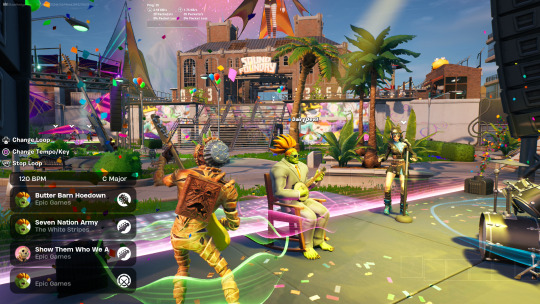
Also included are "Jam Tracks", which let you play specific pieces of songs outside of the Rock Band mode. So if you want, during a Battle Royale match, you could start playing the bassline to Seven Nation Army at any time, anywhere, and even change the pitch and tempo. Other players can choose to join in, adding vocal tracks, or lead guitar, or drums, all from different songs, creating a strange sort of on-the-fly mashup. It's not super deep, but I suppose it's there to justify the fact that songs in Fortnite Festival are roughly $5 each. Festival also has its own Battle Pass, at $18 -- almost twice what the Battle Royal Pass costs, and unlocking stuff on the Festival Pass feels like the slowest possible grind. Too many Festival quests only give 10 or 15 "points" towards the pass, when you often need THOUSANDS for the next unlock. Kind of a bummer!
Battle Royale

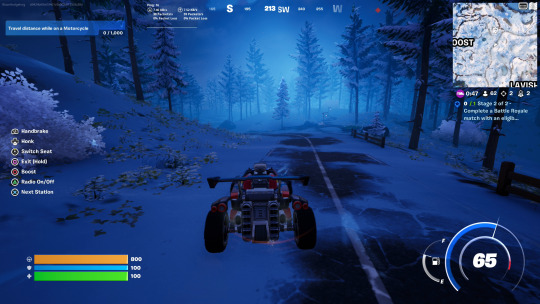
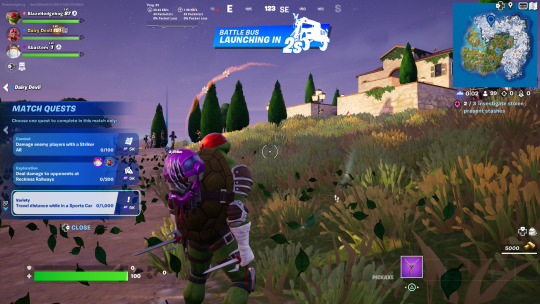
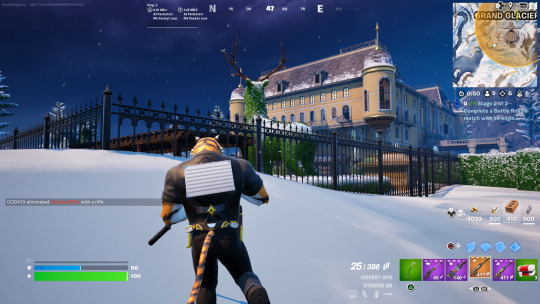
As a bonus, some commentary on the current chapter of BR: as of this latest iteration of Fortnite, it feels like they've basically rebooted the entire game. If you've been paying attention to industry news, Epic's had quite the exodus of high-ranking staff lately, leaving me with a feeling that a completely different team is handling Fortnite now. Every piece of the gameplay has been retooled seemingly overnight, from healing systems to movement speed. The best way to sum it all up is that it feels a lot more like PUBG now. But like, worse? Weapons have attachments now, foregrips and sights and stuff, but there's no way to pull a sight off one gun and put it on another. You can only buy attachments at a workbench, of which there's only, like, seven on the entire map.
So generally you're stuck with whatever attachments are already on a gun when you find it, and there's no easy way to compare attachments if you want to swap for something else. The previous system -- which was basically just WoW's rarity system -- was a lot clearer and easy to understand. A purple gun is always better than blue. Now those waters are a lot muddier, and you don't have access to the information you need to make informed decisions about what is better than what. The simplicity that made Fortnite more accessible than PUBG is gone now. The other changes just take some getting used to, but the slower movement does mean running from a closing storm circle is a lot harder in a way that feels like nobody on the team really understood or accounted for.
The main issue is that Battle Royale is still trying to be the "spotlight" mode in Fortnite right now, which means its trying to incorporate a little bit of everything and it's hurting the experience. The new cosmetics locker system is a total nightmare to use, more tedious in every single conceivable way, to such a degree it's hard to comprehend anyone actually thinking it's a legitimate improvement. Fortnite also tries to pull in your Rocket Racing cosmetics to BR now, but only for certain vehicles, which in itself taps into a long standing frustration with Fortnite's handling of vehicle cosmetics overall.
Close to five years ago, Fortnite introduced its "wraps" system for guns that work like liveries in a racing game -- basically a custom texture for your gun. Wraps have inconsistently applied to other things as well. Fortnite's earliest vehicles like the golf kart and quadbike accepted wraps, as did boats. There are even skins now that can wear wraps as clothing patterns.
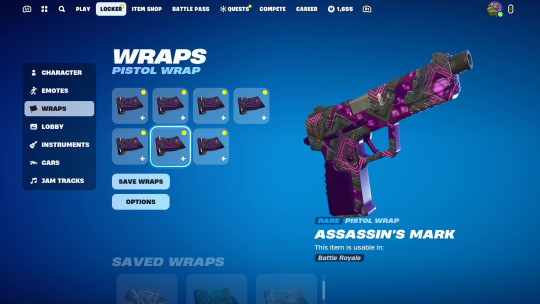
But cars could never have wraps applied to them. There were hints that maybe wraps would eventually apply to vehicles, as there were updates where they started appearing on pieces of a vehicle, but never the whole thing. Now we finally get vehicle cosmetics, but it only applies to one vehicle type, and transforms it into a completely different car body? It feels half-baked and deeply arbitrary.
Fortnite has often had many different vehicle classes on the map together, between pickups, sports cars, sedans, and hauler trucks. But now the sports cars are the Rocket Racing car? It's cool on the surface, but a strange portent of future seasons. What of the other vehicle types? They're not in the game right now, but will they be? Will sports cars be a permanent fixture of the Fortnite map going forward, so the cosmetics always carry across between modes? Is this a hint that other vehicle types are coming to Rocket Racing, and that eventually, we'll be able to apply cosmetics to everything?
Which is to say nothing about the fact that wraps don't even seem to apply to guns anymore. There's a lot of systems that hook into wraps that they can't just get rid of -- but it definitely seems like whoever is in charge of things right now is trying to find a way to ignore them, starting with the core functionality they were invented for.
Like a lot of things about what's happening to Battle Royale in Chapter 5, it feels super weird, and very divorced from the Fortnite I used to know and enjoy. Their attempts to try and tie everything together like this so that Battle Royale can have elements of all (or most) of the other modes incorporated into it just don't mesh very well or feel very necessary. They're recreating and then solving problems that were already solved four years ago.
Which is ultimately the bummer: I'm not sold that any of this needs to be inside of Fortnite, and I don't think it's going to pay off in the end. It's hurting the core experience a little bit and the best, most fun new modes would have still been fun as standalone games.
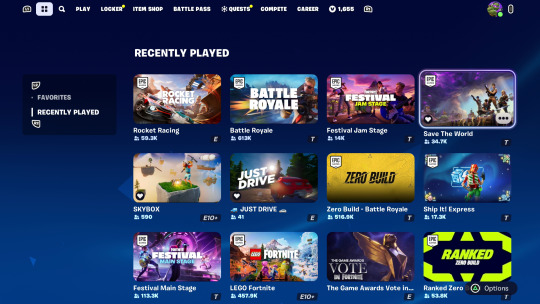
I just don't see the point. How big is big enough, Epic?
#writing#epic games#fortnite#lego fortnite#fortnite festival#rocket racing#psyonix#harmonix#rock band
14 notes
·
View notes
Text
youtube
Downloaded a demo for something called Van Hellswing during one of the previous Steam demo events, basically on the name alone. I saw clips of a grappling hook gun and gothic environments and decided I was sold.
A retro shooter (a, ugh, boomer shooter) mixed with a bit of Castlevania or perhaps Bloodborne flavor? And a grappling hook? I was primed to fall in love.
Tonight, I finally gave it a shot.
Unfortunately, it's a Devil Daggers sort of game where you're locked in a tiny arena and just go for score. I am one of the rare few people on this planet that just did not like Devil Daggers. I thought the aesthetic and monsters were rad, but being trapped in a single tiny room forever did not appeal to me, no matter how well tuned it was. Ergo, Van Hellswing immediately gave me a sour taste.
It does give you a little more space to move around in, and a little more to look at, but I'd argue it's a lot more one-dimensional than Devil Daggers. It's also a demo, so maybe more variety is forthcoming, but right now the only enemies I ever saw were bats of varying color and ability. Some move faster than others, some shoot at you, etc. But they're all the same bat. And all you have is a single charge-up shotgun.
And unlike Devil Daggers, where you're this tight, well-oiled machine that can elegantly glide around the arena, Van Hellswing makes you slow, heavy, and floaty, like a bat-blasting wrecking ball. I was starting to scratch the surface of some of the more fun weight-based tricks you could do with chaining bunny hops and grapples, but my first impressions were not great.
Also the very, very first thing I noticed was the textures.

Van Hellswing sells itself on a retro art style that looks pretty alright as long as you don't stop and stare. Whoever is making the game does not actually seem to know how to have real, genuine retro textures in their games, so what it appears they're doing is taking pixel art and scaling it up to modern texture resolution. If you really look up close, this gives surfaces this strange half-step of looking like pixel art but still getting filtered and compressed. It feels really hack-y and makes it look double gross in a way that isn't retro.
A shame about this one.
4 notes
·
View notes
Text
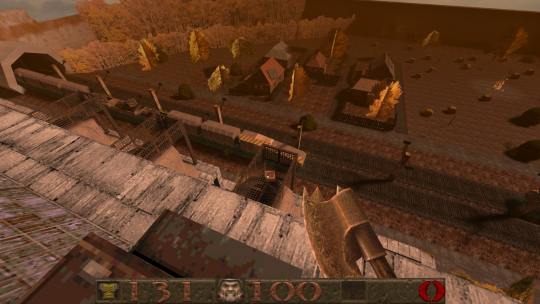



Polished off Jam 3 today. Out of probably 20 maps, I had 4 or 5 left, and as it turns out... a few of these were a little more Halloween oriented. The problem was, some of them just weren't named, so I figured maybe they were the worst maps of the bunch.
Like the top left map: an absolutely massive environment, featuring four houses, a field, trainyard, the ruins of an old apartment complex, and some kind of power plant facility. You are basically turned loose to explore at your leisure. It kind of reminded me of a Painkiller level, where it feels more like a portfolio piece that they jammed monsters into after the fact. I kind of finished it by accident, too. Not super clear what I did.
Top right map felt like a sequel to Jam 2's acid-filled medieval village. I think it was called something like the Necromancer's Swamp? Felt almost like a Metroid game for how it branched off into all these spokes but always returned you to the central hub at the end. Had a boss fight that crashed Quakespasm every time it died. Thankfully, it was easy enough to noclip through the final door it was guarding.
Bottom left was "The Banquet" which was maybe the most normal Quake map of this entire jam. There was some text about how "dinner is served... and you're the main course!" but it barely registered. Nice architecture, though.
Bottom right was a medieval city with stellar art direction. One screenshot doesn't convey much, but it's so full of color, with great lighting and intricate architecture. It's more of a collect-a-thon -- the idea is that there are three books per the four major districts and you have to collect them all to unlock the final challenge and exit the map. Some books require you to puzzle out a platforming challenge, or you get locked in a crypt with some zombies, or you have to solve a small puzzle. Nothing super revolutionary, but it's fun and easy on the eyes.
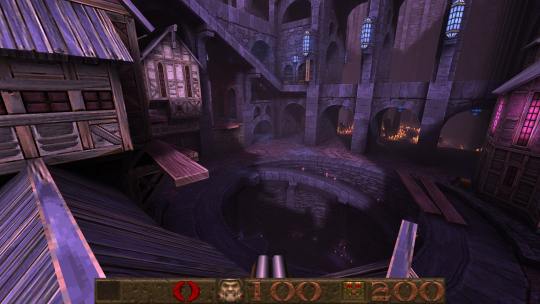
There were a couple of other maps, but I did not take screenshots of them and already they've left my brain.
I think I also have an idea why so many of these maps seem to involve some kind of singular, central zone that must be climbed and explored. These Halloween Jams were hosted by Func_Msgboard, and given the discussions on there, it seems like, beyond the concept of "Halloween", a lot of these maps are trying to replicate the pacing of a Metroidvania.
Suddenly it makes perfect sense! While some of these maps are just regular old Quake maps, a lot of the creative thought was put towards making a space meant to be explored, unlocked, and solved. Some maps even delve into the new power-ups provided by Arcane Dimensions, such as the double jump boots and the blaster belt. Those are supposed to be Metroid-style upgrades! (Like, literally, the Arcane Dimensions documentation describes them as "Vania Items").
Shows why you really should pay attention to the documentation instead of just launching yourself into this stuff completely cold, I guess.
On Quake Halloween Jam 3
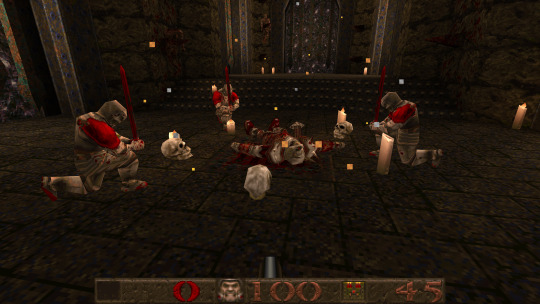


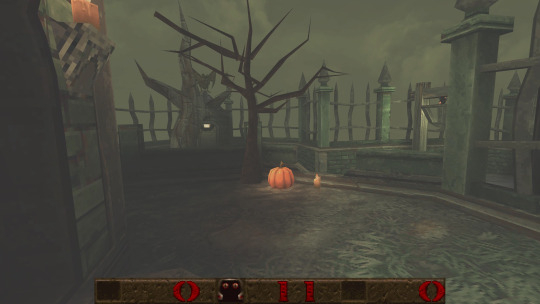
I remember really liking Quake Halloween Jam 2. But with the way things in my life have been since Jam 2, plus my general forgetfulness, it did not even occur to me that there may have been a Quake Halloween Jam 3 or even a 4.
So I've spent a few hours tonight trying to cure a bad mood with a little catharsis via Halloween Jam 3. It works, too. I first figured it out over a decade ago -- I was fooling around in a Garry's Mod zombie slaughter map, just zoning out while I busted props and blew stuff up. When I was done, I realized the grouchy mood I'd been suffering for most of that day was gone and I felt a lot better. It sounds weird, but sometimes you just have pent up anger for whatever reason and video games can be a healthy outlet.
Back to the Halloween Jam, I really enjoyed Jam 2 because it was just a lot of pretty decent Quake maps, but set in places like... a spooky farm during harvest season.
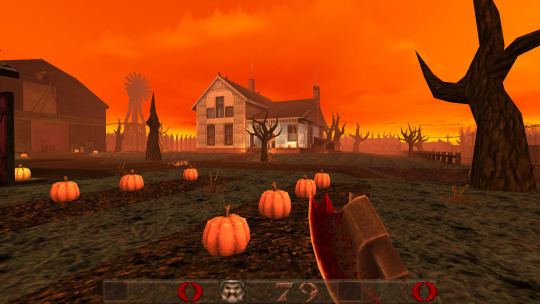
Or a village sieged by neon green acid underneath a purple sky, two of Halloween's signature colors.
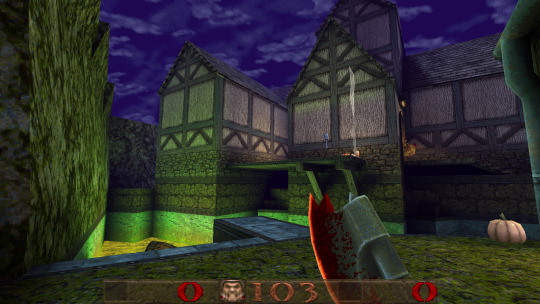
Or even a map set inside and around a gigantic jack-o-lantern.
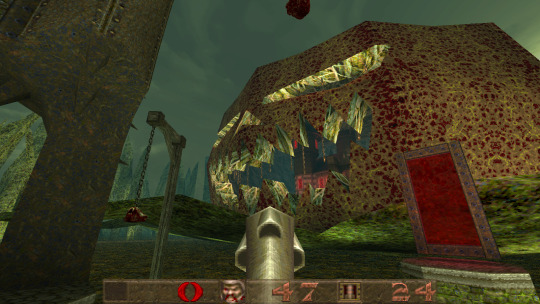
Jam 3's maps are kind of just... regular Quake maps, to some degree. I guess they're sometimes a little darker than usual, but after playing over half of them, there aren't very many that evoke the feeling of Halloween specifically. That's not entirely the Jam's fault, I guess. Until Doom 3, I'd say Quake 1 was the game that felt like it bore the most of iD's horror sensibilities -- its mixture of gothic, sci-fi and cosmic horror gave it a very strange tone, which lends itself very well to spooky maps.
Ironically, one of the very first maps I picked in the Jam was something called "Hall-o-Win" which both demonstrates my point and also acts as maximum catharsis: it's mostly just a series of very long hallways with power-ups at the end and a lot of monsters along the way. A slaughter map in other words, though it does gradually start asking you for more strategy than "blast everything and never stop moving."
youtube
But a theme in a lot of these maps is less Halloween and more just, like, complex mazes. It's probably the pressure of a deadline talking, but a lot of these maps seem to orbit around a single central room that must be scaled, solved, and traversed. Take "Blackvenom Retreat," the greenish map seen at the top of the post. Most of the map is in one central lake area, with three big cubist structures sitting above the water. It plays out like climbing a construction site, as you go up ladders and leap between buildings in search of crystals to power whatever this thing does.
Or "Abbeytoir", a candle lit mansion that feels more like it fell out of Wrath: Aeon of Ruin with its endless hallways and side rooms that all confusingly loop back in on each other. It's not a very big map, but combined with how dark it is, how similar a lot of the rooms look, and how everything has at least 3-5 exits, as I opened up most of the doors near the end of the map I completely lost my ability to navigate when everything blurred into endless stairs, hallways, and switches.
And then there's "Us," a conceptually haunting map where the map creator's body has been disassembled and scattered amongst Quake's brushes. A texture for his head and hair unwrap along the skyline, you'll find nipples you can push like buttons, and floating eyes that watch your every step. "Strange" is putting it mildly, but it too is mainly one big room where the puzzle is to climb up ramps and platforms in order to reach the exit.
But there is one map I unexpectedly fell in love with -- "Approach of the Second Sun." This map is good enough it practically feels like it's own whole separate game.
youtube
The story is that a second, dark sun is approaching our reality, casting its curse on the land. This provides the map with its unique visual style, where the fog is used to invert the light. Effectively, the closer something is to you, the darker it gets. As objects get further away, they fade into the white fog, making for a game of low visibility and eerie silhouettes. The map uses this in its favor, as you spend most of it navigating a ritual site littered with statues, with the twist being that not everything you encounter is actually a statue.
There are tells, of course. Living monsters have subtle idle animations, so if you pay attention closely, you can pick out what's inanimate and what's alive. But the map also knows this, and plays with that expectation sometimes, bringing certain statues to life when you least expect it. It makes you jumpy and paranoid every time you turn a corner and see the outline of a monster and wait for a worst case scenario that doesn't always happen. It's masterclass stuff, and the map is big enough that it took me almost an hour to ultimately solve (like a lot of the other maps, it is a little easy to get lost).
I've got a few more maps left in Jam 3, and then I've got all of Jam 4 to look forward to. Hopefully there's something a little more seasonally flavorful waiting me.
13 notes
·
View notes
Text
On Quake Halloween Jam 3




I remember really liking Quake Halloween Jam 2. But with the way things in my life have been since Jam 2, plus my general forgetfulness, it did not even occur to me that there may have been a Quake Halloween Jam 3 or even a 4.
So I've spent a few hours tonight trying to cure a bad mood with a little catharsis via Halloween Jam 3. It works, too. I first figured it out over a decade ago -- I was fooling around in a Garry's Mod zombie slaughter map, just zoning out while I busted props and blew stuff up. When I was done, I realized the grouchy mood I'd been suffering for most of that day was gone and I felt a lot better. It sounds weird, but sometimes you just have pent up anger for whatever reason and video games can be a healthy outlet.
Back to the Halloween Jam, I really enjoyed Jam 2 because it was just a lot of pretty decent Quake maps, but set in places like... a spooky farm during harvest season.

Or a village sieged by neon green acid underneath a purple sky, two of Halloween's signature colors.

Or even a map set inside and around a gigantic jack-o-lantern.

Jam 3's maps are kind of just... regular Quake maps, to some degree. I guess they're sometimes a little darker than usual, but after playing over half of them, there aren't very many that evoke the feeling of Halloween specifically. That's not entirely the Jam's fault, I guess. Until Doom 3, I'd say Quake 1 was the game that felt like it bore the most of iD's horror sensibilities -- its mixture of gothic, sci-fi and cosmic horror gave it a very strange tone, which lends itself very well to spooky maps.
Ironically, one of the very first maps I picked in the Jam was something called "Hall-o-Win" which both demonstrates my point and also acts as maximum catharsis: it's mostly just a series of very long hallways with power-ups at the end and a lot of monsters along the way. A slaughter map in other words, though it does gradually start asking you for more strategy than "blast everything and never stop moving."
youtube
But a theme in a lot of these maps is less Halloween and more just, like, complex mazes. It's probably the pressure of a deadline talking, but a lot of these maps seem to orbit around a single central room that must be scaled, solved, and traversed. Take "Blackvenom Retreat," the greenish map seen at the top of the post. Most of the map is in one central lake area, with three big cubist structures sitting above the water. It plays out like climbing a construction site, as you go up ladders and leap between buildings in search of crystals to power whatever this thing does.
Or "Abbeytoir", a candle lit mansion that feels more like it fell out of Wrath: Aeon of Ruin with its endless hallways and side rooms that all confusingly loop back in on each other. It's not a very big map, but combined with how dark it is, how similar a lot of the rooms look, and how everything has at least 3-5 exits, as I opened up most of the doors near the end of the map I completely lost my ability to navigate when everything blurred into endless stairs, hallways, and switches.
And then there's "Us," a conceptually haunting map where the map creator's body has been disassembled and scattered amongst Quake's brushes. A texture for his head and hair unwrap along the skyline, you'll find nipples you can push like buttons, and floating eyes that watch your every step. "Strange" is putting it mildly, but it too is mainly one big room where the puzzle is to climb up ramps and platforms in order to reach the exit.
But there is one map I unexpectedly fell in love with -- "Approach of the Second Sun." This map is good enough it practically feels like it's own whole separate game.
youtube
The story is that a second, dark sun is approaching our reality, casting its curse on the land. This provides the map with its unique visual style, where the fog is used to invert the light. Effectively, the closer something is to you, the darker it gets. As objects get further away, they fade into the white fog, making for a game of low visibility and eerie silhouettes. The map uses this in its favor, as you spend most of it navigating a ritual site littered with statues, with the twist being that not everything you encounter is actually a statue.
There are tells, of course. Living monsters have subtle idle animations, so if you pay attention closely, you can pick out what's inanimate and what's alive. But the map also knows this, and plays with that expectation sometimes, bringing certain statues to life when you least expect it. It makes you jumpy and paranoid every time you turn a corner and see the outline of a monster and wait for a worst case scenario that doesn't always happen. It's masterclass stuff, and the map is big enough that it took me almost an hour to ultimately solve (like a lot of the other maps, it is a little easy to get lost).
I've got a few more maps left in Jam 3, and then I've got all of Jam 4 to look forward to. Hopefully there's something a little more seasonally flavorful waiting me.
13 notes
·
View notes
Text
youtube
It's nice to be able to turn a video around in 8 or 9 days as opposed to the 3-5 month death marches the last few videos have felt like
#sega#sonic the hedgehog#sonic superstars#artoon#arzest#blinx the time sweeper#gut check#bltn#video#Youtube
7 notes
·
View notes
Text
youtube
I finished Quake 2 last night, and I was thinking of just jumping straight into Quake 2 N64, but the all-new "Call of the Machine" expansion was next on the menu, so I decided to give it a go.
It's pretty impressive how Machine Games stretches these engines. I remember really liking their Quake 1 episode (Call of the Past) from a few years ago, but they made and released that well before the proper Quake 1 remaster had come out, so it was built more for common Quake 1 source ports, so there wasn't a lot of specialization besides "we can do more complex geometry and have bigger mobs."
The above video doesn't show it off, but their Quake 2 expansion directly takes advantage of the new rendering features provided by Nightdive's update. They deliberately and intentionally play with the upgraded lighting engine in some very pretty ways. Feels a lot closer to a modern retro FPS (Amid Evil, Prodeus, and so on).
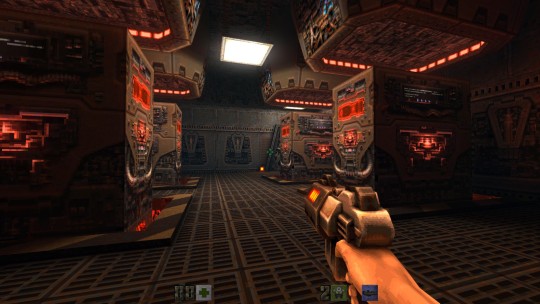
The whole thing is presented in a format very similar a community map jam. You are dropped in to a hub and get to choose which maps you want to play in any order you like; the idea is that each map puts you in the shoes of a different marine as they attempt to survive the assault on the Strogg army.
"Army" is right. I'd say their Quake 1 episode, "Call of the Past," boosted enemy numbers up to be more in line with where most Doom maps fall.
"Call of the Machine" for Quake 2 laughs in the face of that. One of it's favorite party tricks, at least in the three maps I've experienced, is opening doors with 30+ guys behind it. It's like a more claustrophobic Serious Sam. Thankfully, they do at least adjust things for the larger enemy counts -- monsters that were once bullet sponges now aren't quite so hardy. You'll notice in the above video, in one of the expansion's secret levels, waves of basic dudes get turned to mush pretty easily.
Still, it's tough! I'm playing on Normal here and that's at least my sixth (and first successful) attempt.
To be honest, I'm not sure if I like it. Not the difficulty, I'm fine with that, but like a map jam, the quality of all these maps is... a little uneven? I touted the compass as being my savior in the vanilla Quake 2 campaign, and here, it's an absolute necessity. Some maps are constantly making you loop back around and opening doors to let new monsters out, so I've already gotten deeply lost on what I'm doing, why I'm doing it, or where I'm going. If it wasn't for the compass, I would never be able to even make it halfway through some of these maps, because it feels like they're trying to confuse you on purpose.
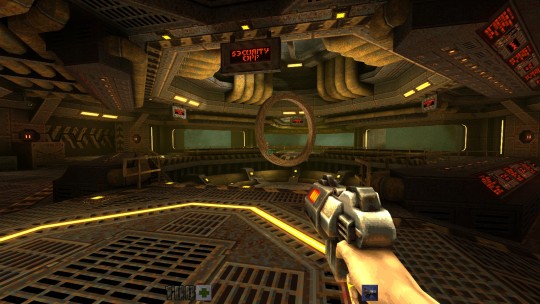
Hopefully there aren't too many more maps like that. Which is the other thing: either I did not finish "Call of the Past" or "Call of the Machine" is ten times larger. There's something like 9-12 maps in this thing. It feels nearly as big as Quake 2 did by itself. Absolutely wild that they did this.
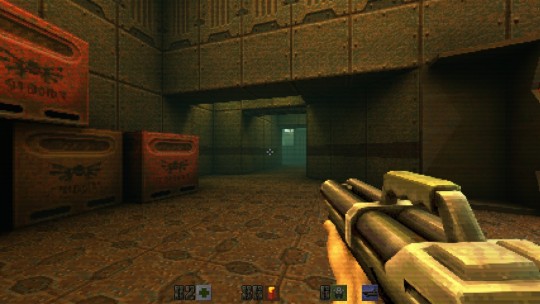
Hey that Quake 2 Remaster is nice
I never loved Quake 2. I didn't have a truly gaming-capable PC until 2003 or 2004, and even then, "gaming capable" meant it could run the NOLF demo on the lowest settings. Then again, maybe Lithtech isn't the best measuring stick.
But it was on that old Sony Vaio that I finally started really playing PC games. And my first priority there was Half-Life, which I played absolutely to death and back. It wasn't until three or even four years later that I even remembered there was a Quake 2, and compared to Half-Life, it felt deeply antiquated.
It felt like a game trying to do everything Half-Life was doing, but still clinging to its roots as the progenitor of Doom's instant action. Those two flavors, at least as far as iD Software mixed them together, were more sour than sweet to me. Modern attempts at designing a living world and a robust story were unable to shake traditional first person shooter cobwebs.
A couple years ago, I think after watching Civvie's video on Quake 2, I made an effort to give the game a second shot through Q2Pro. Though my reception was warmer, I still did not come away feeling especially positive on the game. I'm the kind of guy who was already pretty harsh on Quake 1 for just being "More Doom" and Quake 2 is just More More Doom, but now with extra boring "what if Starship Troopers was about cybernetic horror instead of bugs" art direction.
This Quake 2 Remaster they just put out, though? I'm surprised at how much I'm enjoying the game. Between the enhanced visuals, gameplay tweaks, and improved enemy AI, the game... doesn't feel brand new. It still feels like Quake 2. But it's like somebody went around and tightened all the loose bolts.
Doom 2016 weapon wheels make managing guns (and inventory power-ups!) a breeze. A brand new (and optional) compass makes sure you don't get lost in levels that could take upwards of 40 minutes to finish. Monsters are significantly more mobile and willing to chase you down. And new cutscenes between levels (and better UI during levels themselves) help fill out the struggling narrative a little bit more, putting greater focus on what it is you're doing.
It is, unquestionably, a better version of this game. I can't imagine ever going back to the original Quake 2 now.
Also, shoutouts to the fact that this is two for two that iD Software has said "If you own these games on Steam, you automatically get the remasters for free."
27 notes
·
View notes
Text
And now that this saga is wrapped up in a nice little bow, I feel more comfortable posting it here.
ICYMI: My Sonic Frontiers Criticism/Essay Is Out Now
youtube
So here's the last four months of my life come to fruition: the longest piece of edited criticism I've ever put on my Youtube channel, clocking in at just over an hour. For those of you that may be new around here, I am pretty against making long videos. I don't know if I overthink things too much or what, but it's rare for me to have much tolerance for feature-length reviews of things. They can wear me out just watching them, and it definitely wears me out to make them.
But sometimes you just have a lot to say. And I didn't even necessarily say everything I could have said here; there were things I would have added if not for the looming deadline proposed by the video sponsor. That's not a complaint -- sometimes you need someone else to tell you "be done by this date or else." Limitations foster creativity and toiling away at perfection can sometimes be just as toxic as crunch.
What I was trying to say is it's a big video, and it was hard keeping everything straight in my head because there was so much. One of those times where I was glad how I planned things out in advance, because sometimes the thoughts you had four months ago are not the same thoughts you have today, and the thoughts from four months ago were better.
It's already proving to be a bit of a divisive video, given I am going against the grain here. But I'm a big boy. I've spent time on the front lines of these sorts of things before. I know how to handle myself. I mean, half the reason I started my tumblr back in the day was pointing out some of the truly deranged takes I'd get in the replies to my Sonic 06 video.
Though I do worry. I'm getting a lot of people who are... politely declining to tell me what they think. More than a few "I don't agree with you, but I'm glad you released this video" that then never elaborate further. And that makes me feel bad? But why? Do I want to argue with my friends? Not particularly.
But more to the point, are people afraid to argue with me? Do I get too aggressive? I've picked up on a vibe, not just from friends, where people seem to go out of their way to avoid arguments with and/or around me. I mean I literally just said I started my Tumblr blog as a "get a load of this guy in my comments" spotlight (which, for the record, I don't do anymore). I don't want to be scary. But is it scary, or is it a strength? Or am I just imagining the whole thing? History says it's probably that last one, but it doesn't stop me from wondering. It's a lot to chew on.
At the end of the day, I do think parts of this script could have been better. I do kind of get a little mean at a couple points in ways I could have written around. A lot of people are bristling at the opening spiel, where I get more than a little "you people" about the Game Awards voting situation. There's another part later in the video where I also feature actual comments from a previous video and as I was editing it together I thought, "this sounds mean." But given I was less than 24 hours away from that deadline, I just had to roll with it (so I at least blurred the names and cropped the avatars out).
I'll end this post by quoting what I wrote on Patreon day before yesterday for the early access version of this video:
What a march this has been. I've worked on some videos that felt like they took forever, but nothing like this. This felt like the project that would never end. Some of that's because, after pushing myself so hard on the Sonic Adventure 2 video, I tried to be a little more casual with this one. I think I started the script around the end of April, a couple weeks after finishing the game on-stream. The idea was to avoid burnout. And then the script grew, and grew, and grew, to be the longest script I've ever written. After doing voice over, I had three hours of material I had to cut down. I captured more than 60 hours of gameplay from more than 50 games. Thank goodness I took the time to stop and "storyboard" out this review like I did with the SA2 video. It actually proved to be extremely valuable here -- with a video this long, that takes so long to put together, it's hard to keep all of your ideas hot and ready in your head. Often I'd fall back to the storyboard and realize I planned something months ago that was way better than what I was doing in the moment. And then in July, a sponsor came calling again. Suddenly I had a real deadline. The last four weeks have been a race to move this mountain of material into something resembling the shape of a video. The last couple days in particular have felt something like a miracle. A work ethic I hadn't tapped into in years suddenly roared to life as I locked down 20+ minutes of video in a matter of hours. It may have involved several actual panic attacks and me running on about four hours of sleep, but here we are. I was revising the script all the way up until a week ago. In retrospect, the sponsor segment probably leans a little too much on SAGE content, but by the time I realized that the train was barreling down the tracks too fast to stop. Thoughts for next time, I guess.
Patrons get a PDF of the script I used, including an unfinished earlier draft I abandoned where I think I was actually even meaner about it, if you can believe it. They also get a PDF of what my "storyboarding" process looks like (which is all just text).
I'll probably toss up a post for all the art I made for this video, too.
45 notes
·
View notes
Text
Returning to Donkey Kong Country Returns

I am subjecting myself to Donkey Kong Country Returns again. This game and I have a bit of history.
I'd played Returns on real hardware near when it came out originally, and I sort of hated it. The game felt prohibitively sluggish to me. Some of that is due to Donkey Kong himself, which is made to feel big and heavy like a 300lb gorilla ought to. But some of that was also just, like, a strange problem with input latency. The game did not feel responsive, like I'd push the jump button and it'd take a frame or two for Donkey Kong to actually jump. This made platforming very difficult. Never figured out if I imagined it or if it was a real problem.
Though, for the record, playing Rayman Origins on that same Wii also felt sluggish in the same way as DKCR, leading me to believe it might have been a hardware problem, and not just my imagination. Either way, DKCR made me so mad I didn't even finish the second world, to my memory.
Tropical Freeze, the sequel to DKCR comes, and I receive it for review on TSSZ. I expected to savage that game's controls because of the way I felt with DKCR. Instead, I fall in love with it. Whatever problems I had with the Wii game don't exist in Tropical Freeze. It controls well and plays great. An awesome game.
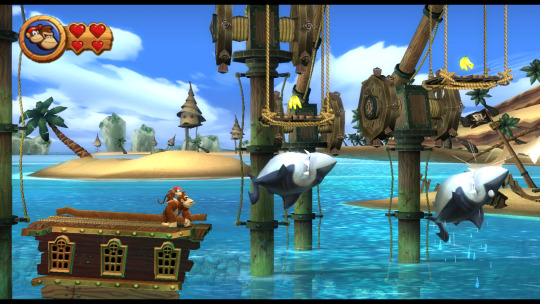
Which makes me wonder: If everybody else loved DKCR, could it really just a hardware problem for me? Could I play DKCR somewhere else and have a better experience? Eventually, Nintendo ran a program where you got a free 3DS game as some kind of reward for a thing they're doing; like, if you buy a certain amount of games in a short length of time you'd get a free game? I forget. Point is, for my free game, I picked the 3DS port of Donkey Kong Country Returns.
And yet, the latency problem persisted even there. The game just felt sluggish and unresponsive and hard to control in a way I didn't enjoy. I guess it probably felt better than it did on the Wii, but not much. I played through over half the game on the 3DS, getting up to the dinosaur/cliff world, but struggled to muster up the energy to finish the rest of the game.
Which brings us here. I don't know why, but I booted DKCR in Dolphin up a couple nights ago and actually spent kind of a long time setting up the controls so that it felt comfortable. It's worth mentioning that when I played DKCR on real hardware back in 2014, I did so with the Gecko Cheat Code to enable Classic Controller Pro support because I refused to waggle. DKCR's waggle was maybe one of the most egregious "this really should have been a button" things ever, to me. Something Tropical Freeze fixed and was much better for!
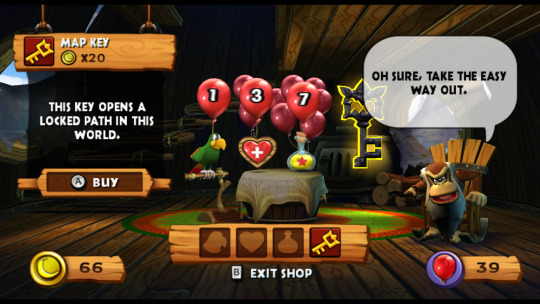
Obviously the Classic Controller support isn't needed on Dolphin, so I just set controller binds so that the R trigger grabs things and the L trigger waggles. Setting up the latter was a little tricky, because DKCR actually looks for you waggling both the remote and nunchuk at the same time in order to register a proper ground pound. An easy problem to solve once you realize what it wants, but it took close to an hour to find that answer.
And it feels... better? Actually? More responsive than it did on real hardware. Which makes me wonder if the Classic Controller code was the source of the dreaded latency -- but then, that wouldn't explain Rayman Origins or the 3DS version of DKCR.
But I also discovered some of these Gecko cheats just don't work, which could explain the problems I had with the original version. I guess I'll never know for sure.
I've turned on a few cheats here -- Diddy has infinite glide now, for instance, making him feel more like Dixie does in Tropical Freeze. And the clock is stopped during bonus rooms, because those never needed time pressure. But originally, I had more cheat codes turned on -- namely one which did remap waggle actions to the remote's B trigger. But turning that cheat just broke many other elements of control, like completely disabling Diddy's hover entirely.
Thus, I was forced to figure out how to properly bind waggle to my Dualshock 4's trigger. Ultimately, no sweat.
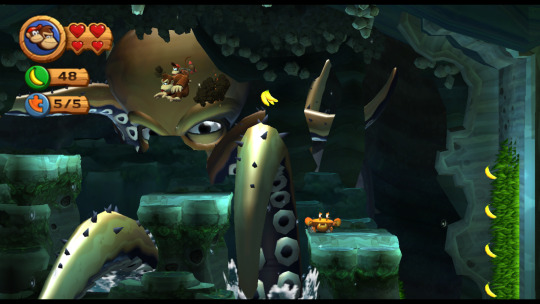
But I still don't know if I'll finish it. Even with the controls feeling "right," the game teeters on the edge of feeling ever so slightly unfriendly. Not much, but the game is weirdly adversarial, like it's trying to trick me into hurting myself. It's a hard thing to describe, and I don't even think everybody picks up on it, but there's a vibe with some retro games where it feels like you're fighting against the game designer themselves, you know?
Games are never just "difficult" or "challenging." There are different flavors these things come in. The way Dark Souls is hard isn't the same way that a shooter like Raiden IV is hard.
In the modern context, DKCR feels closer to something like Kaizo Mario or I Wanna Be The Guy, I guess. Games where you can feel an omnipresent creator watching you play, and they're deliberately trying to trip you up, as if they're shouting "YOU FELL FOR MY TRAP, LOSER!" and laughing at you.
There was a time early in the NES and SNES era where this kind of difficulty was a lot more common, especially in budget or licensed platformers. It's a level beyond the so-called "Nintendo Hard", where some clueless level designer is lost in the wild west of early game development and thinks this is what people want. Obviously games like Kaizo Mario and IWBTG are exaggerated forms of that, but it was definitely a style of game you encountered a lot back in the era.

I never got that vibe from the original Donkey Kong Country games, but DKCR has just a teeny tiny itty bitty sliver of that feel. You reach the third form of the first boss and it's like, "Really? Isn't this a little bit too much for the first boss?"
Who knows if I'll stick with it, but I've already played three sessions already, so it wasn't some kind of one-and-done sort of deal.
I'm surprised how nice it looks in Dolphin even just at 720p. It wouldn't take much work to put this out on the Switch; just clean up some of the GUI. It scales to higher resolutions remarkably well.



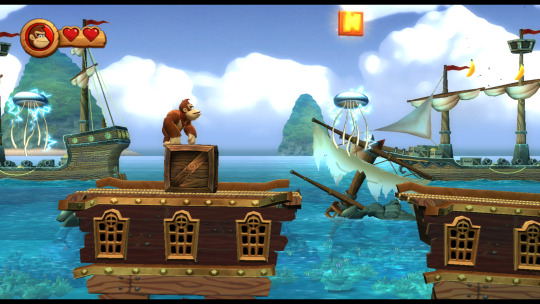
13 notes
·
View notes
Text
youtube
A Korean games board rating for "Sonic Origins Plus" was leaked a few weeks ago. What could that be about? Let's talk about it.
After the agonizingly long and extremely stressful production of the Sonic Adventure 2 video, I challenged myself to do something quick and easy. I feel like I could have had this done a week and a half ago, but I haven't been keeping the most healthy work-life balance. Definitely taking an extended holiday after this.
#video#sonic the hedgehog#sega#sonic team#sonic origins#retro engine#taxman#stealth#gut check#Youtube
10 notes
·
View notes
Text
youtube
Oh right! Things are so crazy for me that I actually forgot to post about this here for almost two weeks. That's because this video took four (almost five) months to put together, and I was fully in vacation mode. But then I got pulled out of vacation mode by something! So expect another video hopefully in the next week.
In the mean time, enjoy this, and tell your friends. And if the sponsor offer tickles your fancy, make sure click through to the Youtube page to use the referral link and fill out the form.
#video#sonic the hedgehog#sega#sonic team#sonic adventure#remaster#remake#the definitive way to play#Youtube
9 notes
·
View notes